- Share full article
Advertisement
Supported by

NASA Seeks a Nuclear-Powered Rocket to Get to Mars in Half the Time

By Kenneth Chang
In less than four years, NASA could be testing a nuclear rocket in space.
The space agency and the Defense Advanced Research Projects Agency, or DARPA, announced on Wednesday that Lockheed Martin had been selected to design, build and test a propulsion system that could one day speed astronauts on a trip to Mars.
BWX Technologies, based in Lynchburg, Va., will build the nuclear fission reactor at the heart of the engine.
The $499 million program is named DRACO, short for the Demonstration Rocket for Agile Cislunar Operations.

A Number That Sums It Up: 3 to 4 months to Mars
What if a spacecraft could get to Mars in half the time it currently takes?
Every 26 months or so, Mars and Earth are close enough for a shorter journey between the worlds. But even then it is a pretty long trip, lasting seven to nine months. For most of the time, the spacecraft is just coasting through space.
But if the spacecraft could continue accelerating through the first half of the journey and then start slowing down again, the travel time could be slashed. Current rocket engines, which typically rely on the combustion of a fuel like hydrogen or methane with oxygen, are not efficient enough to accomplish that; there is not enough room in the spacecraft to carry that much propellant.
But nuclear reactions, generating energy from the splitting of uranium atoms, are much more efficient.
The DRACO engine would consist of a nuclear reactor that would heat hydrogen from a chilly minus 420 degrees Fahrenheit to a toasty 4,400 degrees, with the hot gas shooting from a nozzle to generate thrust. Greater fuel efficiency could speed up journeys to Mars, reducing the amount of time astronauts spend exposed to the treacherous environment of deep space.
Nuclear propulsion could also have uses closer to home, which is why DARPA is investing in the project. The technology may allow rapid maneuvers of military satellites in orbit around Earth.
Background: Back to the future
Nuclear propulsion for space is not a new idea. In the 1950s and 1960s, Project Orion — financed by NASA, the Air Force and the Advanced Research Projects Agency — contemplated using the explosions of atomic bombs to accelerate spacecraft.
At the same time, NASA and other agencies also undertook Project Rover and Project NERVA, efforts that aimed to develop nuclear-thermal engines similar in concept to those now being pursued by the DRACO program. A series of 23 reactors were built and tested, but none were ever launched to space. Until the end of this program in 1973, NASA had contemplated using nuclear reactors to propel space probes to Jupiter, Saturn and beyond, as well as to provide power at a lunar base.
“The technical capabilities, including early safety protocols, remain viable today,” Tabitha Dodson, the DRACO project manager, said in a news briefing on Wednesday.
A key difference between NERVA and DRACO is that NERVA used weapons-grade uranium for its reactors, while DRACO will use a less-enriched form of uranium.
The reactor would not be turned on until it reached space, part of the precautions to minimize the possibility of a radioactive accident on Earth.
“DRACO has already done all of our preliminary analyses across the entire spectrum of possibilities for accidents and found that we’re all the way down in the low probability and all the way down in the teeny tiny amount of release,” Dr. Dodson said.
What Happens Next: A test flight in orbit
The DRACO development is to culminate with a flight test of the nuclear-thermal engine. The launch is currently scheduled for late 2026 or early 2027.
The demonstration spacecraft would most likely orbit at an altitude between 435 and 1,240 miles, Dr. Dodson said. That is high enough to ensure that it stays in orbit for more than 300 years, or long enough for radioactive elements in the reactor fuel to decay to safe levels, she said.
Using information from a news conference, an earlier version of this article misstated when a flight test of a nuclear-thermal engine could occur. The launch is scheduled for late 2026 or early 2027, not late 2025 or early 2026.
How we handle corrections
Kenneth Chang has been at The Times since 2000, writing about physics, geology, chemistry, and the planets. Before becoming a science writer, he was a graduate student whose research involved the control of chaos. More about Kenneth Chang
What’s Up in Space and Astronomy
Keep track of things going on in our solar system and all around the universe..
Never miss an eclipse, a meteor shower, a rocket launch or any other 2024 event that’s out of this world with our space and astronomy calendar .
The company SpaceX achieved a key set of ambitious goals on the fourth test flight of a vehicle that is central to Elon Musk’s vision of sending people to Mars.
Euclid, a European Space Agency telescope launched into space last summer, finally showed off what it’s capable of with a batch of breathtaking images and early science results.
A dramatic blast from the sun set off the highest-level geomagnetic storm in Earth’s atmosphere, making the northern lights visible around the world .
With the help of Google Cloud, scientists who hunt killer asteroids churned through hundreds of thousands of images of the night sky to reveal 27,500 overlooked space rocks in the solar system .
Is Pluto a planet? And what is a planet, anyway? Test your knowledge here .
How Nuclear Technology Will Get Us to Mars Faster Than Ever

Lockheed Martin Selected to Develop the
Nuclear-powered draco spacecraft.
We’ll soon have (nuclear) liftoff! Following the first phase of the Demonstration Rocket for Agile Cislunar Operations (DRACO) program, Lockheed Martin was notified by DARPA that we won the contract to develop and demonstrate a nuclear-powered spacecraft. The project will represent a rapid advancement in propulsion technology to benefit exploration and national defense.
DARPA partnered with NASA’s Space Technology Mission Directorate on the DRACO project, as both agencies will benefit from this leading edge technology.
“This is a prime technology that can be used to transport humans and materials to the Moon,” said Kirk Shireman, vice president of Lunar Exploration Campaigns at Lockheed Martin Space. “A safe, reusable nuclear tug spacecraft would revolutionize cislunar operations. With more speed, agility and maneuverability, nuclear thermal propulsion also has many national security applications for cislunar space.”
In addition to our long history and expertise in nuclear controls, Lockheed Martin is excited to partner with BWX Technologies on DRACO to develop the nuclear reactor and produce the special high-assay low-enriched uranium, or HALEU, fuel. The in-space flight demo of the nuclear thermal rocket engine vehicle is slated to launch no later than 2027.
Follow the link below to learn more about Lockheed Martin and DRACO.
You can’t get all the way to Mars without fuel – and a lot of it.
Chemical propulsion has been the standard for spaceflight for decades, but if humans are to travel to Mars, they need a propulsion technology much more powerful.
“When you get into needing the level of power it takes to advance our exploration of the Moon and send humans to Mars, the only way to do it is nuclear power,” said Rob Chambers, Director of Commercial Civil Space Strategy and Business Development at Lockheed Martin.
“If you want to be able to explore cost-effectively, be Earth-independent and make going to Mars feasible, you need nuclear systems.”
How Nuclear Energy Systems Work (Hint: They’re Safe)
Although they’re relatively new – nuclear systems for propulsion or electrical power are simple.
Fission-based systems work by splitting low-enriched uranium atoms in a reactor to create heat. Super-cooled hydrogen is flowed into the reactor and the heat from the uranium quickly turns the hydrogen into a very hot, pressurized gas.
In nuclear thermal propulsion (NTP), the super-hot pressurized hydrogen is funneled out a nozzle to create a powerful thrust. The mechanics of an NTP engine are much simpler and vastly more efficient than chemical propellent engines.
In fission surface power systems, the heat from the splitting of uranium atoms is converted to electricity. These systems can produce at least 40 kilowatts of power and can operate on permanently shadowed regions of the Moon.
One of the mechanics that makes NTP safe is simply that the mechanics wouldn’t happen on Earth.
A traditional chemical propulsion launch vehicle would lift a spacecraft off Earth’s surface and navigate it to a safe Earth orbit far out of the Earth’s atmosphere. Once in this orbit, the nuclear reactor would be turned on, and the fission process would start. This makes handling and launching a reactor with the high assay low enriched uranium (HALEU) fuel very safe.
Defining the level of ground testing that’s needed to prove safe, effective operations in space is part of Lockheed Martin’s current efforts, too.
“Ground testing helps us understand what the expected behavior and limitations of the nuclear reactor are and how we expect it to respond and interact with the control systems that we’re developing,” said John Bendle, Senior Manager, Strategy and Business Development, Human Space Exploration, Lockheed Martin.
Why Nuclear Thermal Propulsion?
In short: speed, efficiency and reusability.
NTP will enable faster space travel than ever before.
Increased speed from NTP means benefits like longer launch windows, less crew exposure to cosmic radiation in space and satellites and robotic spacecraft getting to their destinations quicker or with much higher mass.
The speed of NTP comes from its high-efficiency thrust—upwards of two times more efficient than conventional propulsion systems.
“It could take a hundred launches to get humans to Mars on a chemical propulsion system, but we can get it down to five with a nuclear thermal propulsion system,” said Chambers.
NTP’s efficiency can also enable more abort options during missions.
Other benefits include maximum reusability and extensibility to other missions. NTP allows the use of fewer refuelers than other systems – making it an environmentally cleaner, more efficient way to fuel.
“If we want to get serious about deep space exploration, a reusable nuclear system is a cleaner, more efficient way to achieve our goals,” said Bendle. “NTP will enable us to extend our exploration beyond the Moon more quickly than other alternatives might.”
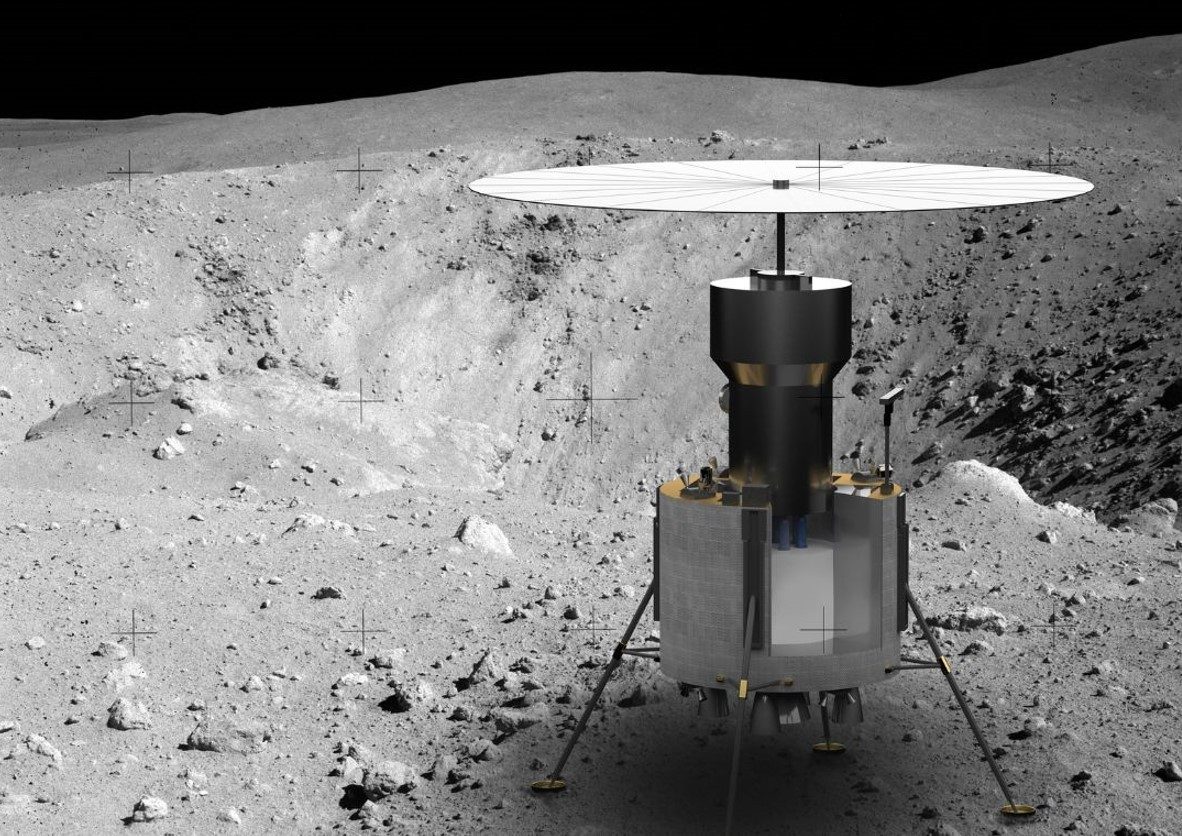
An Economy on the Moon and Other Possibilities
Making safe nuclear systems a reality is within our reach – and with it, so are massive changes in the way we do space exploration.
“Surface fission power would mean a stable, Earth-independent power source on the Moon and Mars,” said Lisa May, Principal Engineer and Next Gen Strategy Lead, Lockheed Martin.
High-power fission-based systems on the Moon would enable splitting lunar water into hydrogen that can be used for propellant, and oxygen for astronauts to breathe.
“We envision a water-based economy on the Moon, where what we need to fuel space travel can be extracted, traded and utilized on the Moon,” said Chambers.
Time to Turn Vision into Reality
Lockheed Martin’s space nuclear systems work includes three current contracts – a partnership with BWXT Technologies on both nuclear thermal reactor and fission surface power concepts for NASA and the Department of Energy , and a contract with the Defense Advanced Research Projects Agency to develop a spacecraft concept design with NTP capability.
While nuclear systems are an emerging field, Lockheed Martin has a long history and expertise in nuclear controls, having supported instrumentation and controls for both terrestrial power plants and Naval nuclear reactors. Lockheed Martin’s expertise in avionics, mission control and integration give us leverage.
“Our discriminator also comes from our deep space exploration heritage, which requires the ability to do high-technology, first-of-a-kind missions,” said May. “We’ve also invested heavily in cryogenic hydrogen storage and transfer, as well as the overall nuclear reactor controls.”
The company also built the radioisotope thermoelectric generators for NASA planetary missions such as Viking, Pioneer, Voyager, Apollo, Cassini and New Horizons.
Covering the business and politics of space
Space Force sees ‘advantages and opportunities’ in nuclear-powered space missions

- Click to share on X (Opens in new window)
- Click to share on Facebook (Opens in new window)
- Click to share on LinkedIn (Opens in new window)
- Click to share on Reddit (Opens in new window)
- Click to email a link to a friend (Opens in new window)
- Click to share on Clipboard (Opens in new window)

Join our newsletter to get the latest military space news every Tuesday by veteran defense journalist Sandra Erwin.
By clicking submit, you agree to share your email address with the site owner to receive the newsletters. You can opt-out at any time.
WASHINGTON — Space vehicles powered by small nuclear reactors — a technology that NASA believes could help get humans to Mars faster — also could be used for military missions in deep space, the vice chief of the U.S. Space Force said July 28.
Nuclear propulsion “holds the potential for significant advantages in terms of efficiency compared to standard chemical rockets,” Gen. David Thompson said on a virtual forum hosted by the Mitchell Institute.
“It expands the envelope in how far you can go,” Thomson said.
NASA for decades has been interested in nuclear propulsion for space exploration. The Space Force currently does not send missions beyond Earth’s orbit but might have to do that one day , officials predict.
Current electric and chemical space propulsion systems have drawbacks and limitations for long-endurance missions in deep space so nuclear propulsion is worth considering, Thompson said.
“As you, no kidding, look at operating long term and sustainment in space, I think absolutely the nation has to look again at what its use is,” the said of nuclear energy.
“We know NASA is looking at this,” Thompson said.
One scenario the Space Force is planning for is to be able to deploy and move satellites or other vehicles around cislunar space — the vast region between the Earth and the moon. That creates a challenge for traditional technologies like solar-powered systems, Thompson noted. “The further away you get from the sun the harder it is for solar panels,” he added. “Solar panels are large and flimsy, they also limit your ability to maneuver quickly.”
There has been historical resistance to the use of nuclear power so there are “policy considerations” the Space Force would have to weigh, Thompson said. “But Space Force has to look hard at the advantages and opportunities of nuclear power and nuclear propulsion.”
DARPA demonstration
A demonstration of a nuclear-powered space vehicle is now being planned by the Pentagon’ technology arm, the Defense Advanced Research Projects Agency.
DARPA in April awarded a $22 million contract to General Atomics to design a small nuclear reactor for space propulsion, It also awarded $2.9 million and $2.5 million contracts to Lockheed Martin and Blue Origin respectively to design spacecraft concepts for the DRACO program, short for Demonstration Rocket for Agile Cislunar Operations.
The thinking is that nuclear thermal propulsion will allow spacecraft to travel across the solar system relatively quickly, DRACO program manager Nathan Greiner told SpaceNews July 28.
A mission that would take months or years with conventional propulsion could be accelerated to days or weeks, he said.
DARPA’s concept is a nuclear thermal engine that uses nuclear fission to heat liquid hydrogen, which serves a propellant to create thrust.
Greiner noted that most of the funding is going into the reactor because that is the most technologically risky part of the program.
“The focus is on developing and demonstrating the engine capability, the nuclear thermal propulsion which in itself is a really quite complicated and quite challenging problem,” he said.
The DRACO mission will be a “test range in the sky” to evaluate the propulsion system on orbit.
DARPA has not yet set a target launch date or selected a launch vehicle for this project. “We are still sizing the vehicle,” Greiner said.
How the Space Force could employ a nuclear-powered spacecraft is not for DARPA to decide, he said. The goal is to “get DoD to understand that this capability is real.”
“It’s a culture shift to go from existing systems to something as advanced and enabling as this could be,” Grenier said.
On the question of the safety of using nuclear reactors, there is always skepticism, he said. “It is more of an education process,” he added. The space industry for decades has used nuclear batteries known as radioisotope thermoelectric generators as power sources in satellites and space probes, Grenier noted, so there’s a “lot of radioactivity” in space systems that has not harmed the public.
Sandra Erwin
Sandra Erwin writes about military space programs, policy, technology and the industry that supports this sector. She has covered the military, the Pentagon, Congress and the defense industry for nearly two decades as editor of NDIA’s National Defense... More by Sandra Erwin

Sign up for a SpaceNews newsletter
Get top stories, military space news and more delivered to your inbox.
The June 2024 issue of IEEE Spectrum is here!
For IEEE Members
Ieee spectrum, follow ieee spectrum, support ieee spectrum, enjoy more free content and benefits by creating an account, saving articles to read later requires an ieee spectrum account, the institute content is only available for members, downloading full pdf issues is exclusive for ieee members, downloading this e-book is exclusive for ieee members, access to spectrum 's digital edition is exclusive for ieee members, following topics is a feature exclusive for ieee members, adding your response to an article requires an ieee spectrum account, create an account to access more content and features on ieee spectrum , including the ability to save articles to read later, download spectrum collections, and participate in conversations with readers and editors. for more exclusive content and features, consider joining ieee ., join the world’s largest professional organization devoted to engineering and applied sciences and get access to all of spectrum’s articles, archives, pdf downloads, and other benefits. learn more →, join the world’s largest professional organization devoted to engineering and applied sciences and get access to this e-book plus all of ieee spectrum’s articles, archives, pdf downloads, and other benefits. learn more →, access thousands of articles — completely free, create an account and get exclusive content and features: save articles, download collections, and talk to tech insiders — all free for full access and benefits, join ieee as a paying member., nuclear-powered rockets get a second look for travel to mars , nasa is investing in the technology for future space exploration missions.
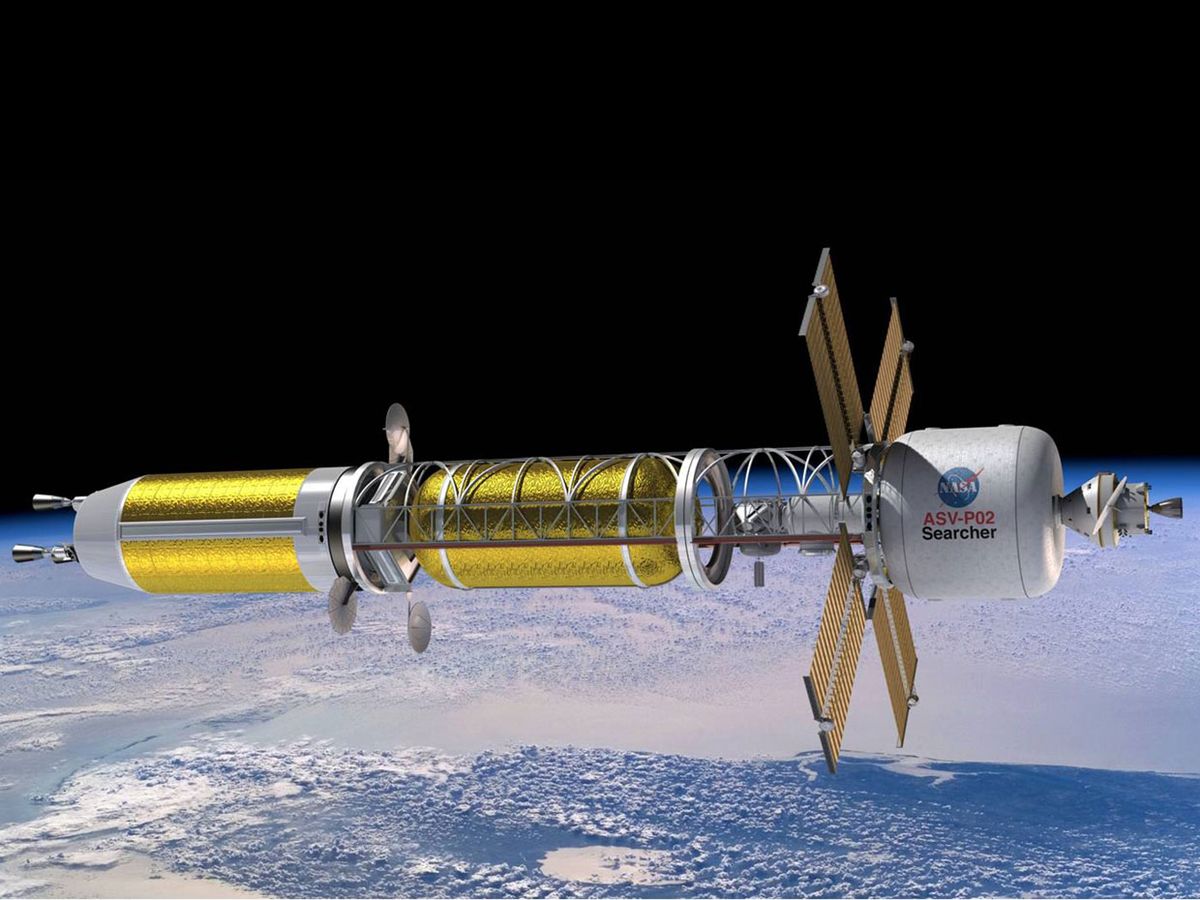
Atoms for Propulsion: Rockets powered by nuclear fission or fusion are now vying to become the preferred (and faster) means of traveling the solar system.
For all the controversy they stir up on Earth, nuclear reactors can produce the energy and propulsion needed to rapidly take large spacecraft to Mars and, if desired, beyond. The idea of nuclear rocket engines dates back to the 1940s . This time around, though, plans for interplanetary missions propelled by nuclear fission and fusion are being backed by new designs that have a much better chance of getting off the ground.
Crucially, the nuclear engines are meant for interplanetary travel only, not for use in the Earth's atmosphere. Chemical rockets launch the craft out beyond low Earth orbit. Only then does the nuclear propulsion system kick in.
The challenge has been making these nuclear engines safe and lightweight. New fuels and reactor designs appear up to the task, as NASA is now working with industry partners for possible future nuclear-fueled crewed space missions. “Nuclear propulsion would be advantageous if you want to go to Mars and back in under two years," says Jeff Sheehy , chief engineer in NASA's Space Technology Mission Directorate . To enable that mission capability, he says, “a key technology that needs to be advanced is the fuel."
Specifically, the fuel needs to endure the superhigh temperatures and volatile conditions inside a nuclear thermal engine. Two companies now say their fuels are sufficiently robust for a safe, compact, high-performance reactor. In fact, one of these companies has already delivered a detailed conceptual design to NASA.
Nuclear thermal propulsion uses energy released from nuclear reactions to heat liquid hydrogen to about 2,430 °C—some eight times the temperature of nuclear-power-plant cores. The propellant expands and jets out the nozzles at tremendous speeds. This can produce twice the thrust per mass of propellant as compared to that of chemical rockets, allowing nuclear-powered ships to travel longer and faster. Plus, once at the destination, be it Saturn's moon Titan or Pluto, the nuclear reactor could switch from propulsion system to power source, enabling the craft to send back high-quality data for years.
Getting enough thrust out of a nuclear rocket used to require weapons-grade, highly enriched uranium. Low-enriched uranium fuels, used in commercial power plants, would be safer to use, but they can become brittle and fall apart under the blistering temperatures and chemical attacks from the extremely reactive hydrogen.
However, Ultra Safe Nuclear Corp. Technologies (USNC-Tech), based in Seattle, uses a uranium fuel enriched to below 20 percent, which is a higher grade than that of power reactors but “can't be diverted for nefarious purposes, so it greatly reduces proliferation risks," says director of engineering Michael Eades. The company's fuel contains microscopic ceramic-coated uranium fuel particles dispersed in a zirconium carbide matrix. The microcapsules keep radioactive fission by-products inside while letting heat escape.
Lynchburg, Va.–based BWX Technologies , is working under a NASA contract to look at designs using a similar ceramic composite fuel—and also examining an alternate fuel form encased in a metallic matrix. “We've been working on our reactor design since 2017," says Joe Miller, general manager for the company's advanced technologies group.
Both companies' designs rely on different kinds of moderators. Moderators slow down energetic neutrons produced during fission so they can sustain a chain reaction, instead of striking and damaging the reactor structure. BWX intersperses its fuel blocks between hydride elements, while USNC-Tech's unique design integrates a beryllium metal moderator into the fuel. “Our fuel stays in one piece, survives the hot hydrogen and radiation conditions, and does not eat all the reactor's neutrons," Eades says.
Princeton Plasma Physics Laboratory scientists are using this experimental reactor to heat fusion plasmas up to one million degrees C—on the long journey to developing fusion-powered rockets for interplanetary travel.
There is another route to small, safe nuclear-powered rockets, says Samuel Cohen at Princeton Plasma Physics Laboratory : fusion reactors. Mainline fusion uses deuterium and tritium fuels, but Cohen is leading efforts to make a reactor that relies on fusion between deuterium atoms and helium-3 in a high-temperature plasma, which produces very few neutrons. “We don't like neutrons because they can change structural material like steel to something more like Swiss cheese and can make it radioactive," he says. The Princeton lab's concept, called Direct Fusion Drive , also needs much less fuel than conventional fusion, and the device could be one-thousandth as large, Cohen says.
Fusion propulsion could in theory far outperform fission-based propulsion, because fusion reactions release up to four times as much energy, says NASA's Sheehy. However, the technology isn't as far along and faces several challenges, including generating and containing the plasma and efficiently converting the energy released into directed jet exhaust. “It could not be ready for Mars missions in the late 2030s," he says.
USNC-Tech, by contrast, has already made small hardware prototypes based on its new fuel. “We're on track to meet NASA's goal to have a half-scale demonstration system ready for launch by 2027," says Eades. The next step would be to build a full-scale Mars flight system, one that could very well drive a 2035 Mars mission.
This article appears in the January 2021 print issue as “Nuclear-Powered Rockets Get a Second Look."
- A Helicopter Will Try to Catch a Rocket Booster Mid-Air - IEEE Spectrum ›
- Pentagon Aims to Demo a Nuclear Spacecraft Within 5 Years - IEEE Spectrum ›
- DARPA and NASA Aim to Test Nuclear Rocket by 2026 - IEEE Spectrum ›
Prachi Patel is a freelance journalist based in Pittsburgh. She writes about energy, biotechnology, materials science, nanotechnology, and computing.
Video Friday: 1X Robots Tidy Up
Errors in navigational models could have an easy answer, this japanese aircraft became a 5g base station, related stories, the space-based drug factory that can’t come home, the race for the next-gen space station, can this diy rocket program send an astronaut to space.
Read the May magazine issue on food and climate change
Is using nuclear materials for space travel dangerous, genius, or a little of both?
By Susan D’Agostino | July 28, 2021
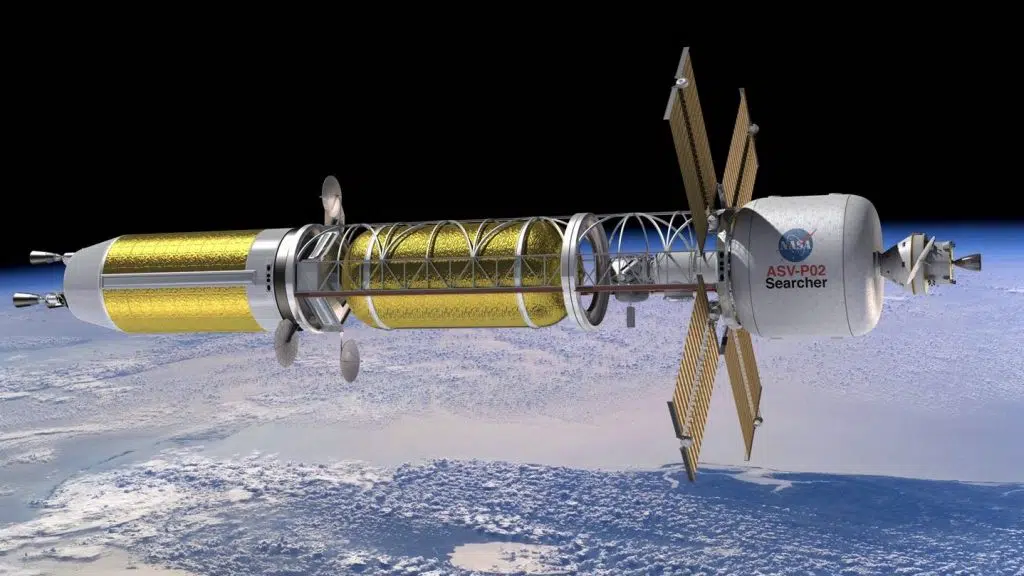
- Copy link Linked copied
The 1977 Soviet satellite Kosmos 954 was supposed to monitor ocean traffic using radar—a technology that works best at short distances. For this reason, the craft traveled in Earth’s low orbit, where solar panels alone could not provide consistent power. And so, the satellite was equipped with a small, efficient, yet powerful nuclear reactor fueled by approximately 50 kg of weapons-grade uranium 235. Within weeks of its launch, Kosmos 954 veered from its path like a drunkard on a walk. The Soviets tried to eject its radioactive core into a higher orbit by way of a safety system designed for that purpose. But the safety system failed. In January 1978, Kosmos 954 burst into the Western Canada skyline, scattering radioactive dust and debris over a nearly 400-mile path. The cleanup and recovery process, which took nearly eight months and started in the subarctic winter, found that virtually all of the satellite fragments were radioactive, including one that was “ sufficient to kill a person or number of persons remaining in contact with that part for a few hours.”
Now that the United States has set a goal of a human mission to Mars by 2039, the words “nuclear” and “space” are again popping up together in newspaper headlines. Nuclear propulsion systems for space exploration—should they materialize—are expected to offer significant advantages, including the possibility of sending spacecraft farther, in less time, and more efficiently than traditional chemical propulsion systems. But extreme physical conditions on the launchpad, in space, and during reentry raise questions about risk-mitigation measures, especially when nuclear materials are present. To realize the goal of a nuclear-propelled, human mission to Mars, scientists must overcome significant challenges that include—but go beyond—the technical. That is, any discussion about such an uncommon journey must also consider relevant medical, environmental, economic, political, and ethical questions.
Why not travel to Mars on a chemically propelled spacecraft? Spaceships that use chemical propellants benefit from tremendous thrust to get the job done. However, they also need to carry fuel and oxidizer to power that incredible upward or forward movement. For example, NASA succeeded in traversing the approximately 240,000 miles from Earth to the moon on chemically propelled spacecrafts. It has also flown rovers to Mars, which averages 225,000,000 miles away from Earth, by way of chemical propulsion. But a human-crewed trip from Earth to the Red Planet on a chemically fueled spaceship would require 1,000-4,000 tons of fuel—an impractical amount.
“There is no perfect propulsion system for all missions out there. You have to select the appropriate propulsion system for the mission that you’re trying to achieve,” Kareem Ahmed , a mechanical engineer at the Propulsion and Energy Research Lab at the University of Central Florida, said.
Nonetheless, SpaceX , the American aerospace manufacturer founded by Elon Musk, seeks to overcome the challenge of sending a chemically propelled rocket to Mars by building infrastructure to refuel in space and manufacture propellant on the surface of Mars. Transferring cryogenic propellants —”gases chilled to subfreezing temperatures and condensed to form highly combustible liquids”—in zero gravity represents a nontrivial challenge. Also, the company will need a power source on Mars to manufacture propellant. SpaceX did not respond to a request for comment.
“I’d caution [SpaceX] to think about the amount of infrastructure in space and infrastructure on the surface of Mars that’s necessary to be successful,” Roger Meyers said. Meyers is a consultant to NASA who co-chaired the National Academies of Sciences, Engineering, and Medicine’s committee that wrote the report, Space Nuclear Propulsion for Human Mars Exploration , released earlier this year. “I applaud the effort and hope it’s successful. But given what we know today, it would not be prudent [for NASA] to down select to one technology or another. We should be pursuing multiple pathways at an appropriate level in order to make sure that we’re ready.”
Even if a spacecraft were able to refuel with a chemical propellant in space or magically carry enough chemical propellant for the journey to Mars, the long transit time would present a hazard to the crew. To minimize the amount of fuel required, the astronauts would need to chart the shortest path between the two planets. Such a path, which relies on orbital mechanics, occurs only once every 26 months . The complete journey, including time for the round-trip flights and waiting time on Mars for optimal planetary realignment, could require more than three years , which would expose the crew to a significant amount of cosmic radiation and increase their lifetime risk of cancer. Also, to state the obvious, the more time astronauts spend in space, the more time there is for something to go wrong.
In theory, nuclear propulsion for space travel will offer two significant advantages over chemical propulsion. First, since nuclear systems are much more efficient , the amount of fuel required for the journey to Mars is practical. Second, without a need to traverse the shortest path, the flight could take off from Earth and Mars anytime—without delay. The latter would reduce the length of the roundtrip journey and the crew’s exposure to radiation.
Still, attaching what amounts to a nuclear reactor to a human-occupied spaceship is not without risks.
Is the idea of sending nuclear materials into space new? The idea of sending nuclear materials into outer space is not new. And unlike Kosmos 954, many instances have been successful. Since 1961, NASA has powered more than 25 space missions with nuclear materials. The only other practical power option —solar power—is often unavailable in dark, dusty, far-off corners of the solar system.
Likewise, the Atomic Energy Commission launched a nuclear-thermal rocket propulsion research and development program in 1955. Around that time, the Los Alamos and Lawrence Livermore Laboratories also initiated exploratory research on nuclear propulsion for rocket engines. When NASA was established in 1958, the United States shifted its nuclear-propulsion research focus from missile applications to lunar and planetary missions. Regrettably, funding and interest in the programs dried up in the 1970s, but not before fundamental research and testing had been executed—and deemed successful .
What new plans does the United States have for sending nuclear materials to space? The National Academies’ report released earlier this year recommended that NASA “ commit within the year to conducting an extensive and objective assessment of the merits and challenges of using different types of space nuclear propulsion systems and to making significant technology investments this decade.” The report offers a roadmap for developing two different kinds of propulsion systems—nuclear electric and nuclear thermal—for human missions to Mars.
A nuclear electric propulsion system bears some resemblance to a terrestrial power plant. That is, first a fission reactor generates power for electric thrusters. That power positively charges the ions in the gas propellant, after which electric, magnetic, or electrostatic fields accelerate the ions. The accelerated ions are then pushed out through a thruster, which propels the spacecraft.
Alternatively, in a nuclear thermal propulsion system , the reactor operates more as a heat exchanger in which a fuel such as liquid hydrogen is first heated to very high temperatures—up to 4,600 degrees Fahrenheit —that is then exhausted through a rocket nozzle to produce thrust.
“For nuclear thermal propulsion, the challenge is: temperature, temperature, temperature,” Anthony Calomino, a materials and structure research engineer at NASA’s Langley Research Center, said. “There are not many materials that can survive those kinds of temperatures.” The potential payoff, should NASA meet the challenge, will be significant: Nuclear thermal propulsion systems are expected to twice as efficient as traditional chemical propulsion systems.
“It’s like a Corvette versus a Prius. Both will get you from A to B, but a Prius gets you there more efficiently while a Corvette will get you there quickly using more gas,” Ahmed said of the difference between nuclear and chemical propulsion systems for space travel.
While nuclear electric propulsion systems do not require extreme temperatures, they face a different hurdle. Nuclear electric systems have six subsystems , including a reactor, shield, power conversion, heat rejection, power management and distribution, and electric propulsion systems. The operating power of all of these subsystems will need to be scaled up by orders of magnitude —and in such a way that they continue to work together—before they are ready for space.
“For nuclear electric propulsion, the challenges are developing a power reactor for space operation. It’s going to be very different than what we do here on earth ,” Calomino said. Still, nuclear electric propulsion systems are also expected to be much more efficient than traditional chemical propulsion systems.
“It’s really important to invest in both technologies to get to the point where we have enough data to down select,” Meyers said. “Making a decision too early is not smart if you’re trying to manage the risk.”
Earlier this year, the Defense Advanced Research Projects Agency (DARPA) awarded three multimillion-dollar contracts to companies for the first phase of a project designed to test nuclear-thermal propulsion systems.
Why might US funding be directed at one technology over another? Though the National Academies’ report recommends researching both kinds of nuclear propulsion systems, funding to support nuclear thermal research has been more forthcoming than that for nuclear electric.
“It has to do with politics and senators wanting to fund certain centers,” Myers said. “They’re advocating for work in their districts, just like they should be. I would not say it’s a well-informed decision. I would say it’s a let’s-get-this-potentially-big-program-into-my-district decision.”
How are the risks of nuclear-propelled spacecraft mitigated? To be sure, engineers have learned a lot since the crash of Kosmos 954. The scientific community and US government have identified some non-negotiable mitigation measures to protect the crew or, in the event of a launch failure or accident, people on Earth.
Nuclear propulsion systems will not activate during launch. Despite the name, nuclear-propelled, human-crewed spacecrafts will have one big asterisk; they will be launched with chemical propulsion systems. The nuclear reactor will only operate once the vehicle has left Earth’s atmosphere. This design feature is intended to minimize the risk of releasing radioactive materials in the event of an accident on the launchpad.
“NASA’s priority is always safety first—not just safe for the astronauts but for the ground crews that support them as well as the environment,” Calomino said.
Nuclear propulsion systems on spacecraft will only operate beyond Earth’s atmosphere.
Should a nuclear-propelled spacecraft have an accident beyond Earth’s low orbit , it would remain in space rather than fall to Earth where it could harm people or the environment. Likewise, in the event of an accident, the radioactive debris would remain in orbit for tens of thousands of years , during which time it would decay.
“[Kosmos 954] showed the importance of using nuclear-safe orbits where you launch to thousands of kilometers rather than 200-300,” Myers said.
Shields will protect the astronauts from onboard radioactive materials. Nuclear propulsion systems will incorporate physical shields into their engineering designs, according to Calomino. In addition, the vehicle’s fuel tanks, which will be placed between the reactor and the crew, will provide additional protection.
“Especially for nuclear thermal propulsion, the fuel is hydrogen which is a great shield by itself,” Meyers said. Still, the calculation is made based on the lowest levels of fuel at the end of the mission, according to Meyers.
“We’re following design standards that are used here on Earth for [permissible radiation exposure],” Calomino said. “The bigger problem is protecting the astronauts against cosmic radiation.”
Nuclear propulsion systems will not use nuclear materials that could be diverted for illicit purposes. NASA is pursuing designs that are fueled by low enriched uranium . This approach is similar, though not identical to, terrestrial reactors. The uranium in use at commercial power plants is typically enriched up to five percent, which is insufficient for nuclear propulsion systems. For space travel, the uranium will need to be enriched up to 19.75 percent.
“[19.75 percent] is the highest enrichment that can still be classified as low enriched,” Meyers said. Enrichment that exceeds 20 percent could be used to build a nuclear weapon or improvised nuclear device.
“We are concerned with proliferation issues,” Calomino said.
Why is the United States planning to send humans to Mars anyway? Some argue that the scientific value of a human-crewed Mars mission could be captured by robots at a much lower cost and risk . Others think that humans, whose role in terrestrial climate change is apparent, should first rehabilitate Earth before colonizing other planets. Still others worry that human microbes could contaminate the Red Planet.
Indeed, a majority of Americans—63 percent according to a 2018 Pew Research Center survey —believe that NASA should prioritize monitoring Earth’s climate system. Only a minority—18 percent—said that NASA should prioritize sending humans to Mars.
But enthusiasts exist. Celebrated theoretical physicist and cosmologist Stephen Hawking (1942-2018) was nearly certain that Earth-bound humans would one day face a low-probability, high-impact catastrophe—from an asteroid strike, artificial intelligence, climate change, genetically modified virus, or nuclear war. To survive, he recommended that humans leave Earth and settle on other planets such as Mars.
Many government policymakers, scientists, and citizens agree—at least with the part about trying to get humans to Mars.
“Talk to a field scientist today. Ask if their job could be done by a robot,” Meyers said. “Robots should continue to do what they’re doing. But there are limits to what robots can do, and that’s where people come in.”
For some Americans, the argument in support of human missions to Mars boils down to this: To maintain competitiveness on an already-here, deep-space stage that may one day include international commercial markets and capabilities, the United States must invest in a transportation system now. If it does not, another nation will. And the investment at the moment is focused—for good reasons—on nuclear technologies.
“We should not continue to use old tools to get a job done that one day [makes] you no longer relevant on the world stage,” Calomino said. “It’s important for the United States to remain a primary and dominant player in space. It is the next frontier.”
But the United States expects to take at least until 2039 before it starts to conquer this new space frontier. Until then, world citizens are encouraged to engage in that celebrated, if somewhat battered, element of democratic societies: open debate, especially about the still-unanswered technical, medical, environmental, economic, political, and ethical questions related to a human journey to Mars on a nuclear-propelled rocket.
Together, we make the world safer.
The Bulletin elevates expert voices above the noise. But as an independent nonprofit organization, our operations depend on the support of readers like you. Help us continue to deliver quality journalism that holds leaders accountable. Your support of our work at any level is important . In return, we promise our coverage will be understandable, influential, vigilant, solution-oriented, and fair-minded. Together we can make a difference.
Keywords: NASA , SpaceX , nuclear electric propulsion , nuclear propulsion , nuclear thermal propulsion , space Topics: Analysis , Nuclear Energy , Nuclear Risk , Opinion
Hmmm. Space travel is a vain and earth destroying idea. To promote it is to move in the direction diametrically opposed to The Bulletin’s mission statement.
If I was considering nuclear rocket engine I would first do a system analysis of a liquid salt Thorium reactor. With the Thorium reactor the reactor could be orbited in an inert condition (no radioactive materials). The radioactive seed (a small amount of either U235 or Plutonium) could be orbited separately in a container that could survive reentry if there was an accident. The reactor and engine would be activated in orbit and would then leave Earth orbit. Or you could just jump to the system that you really need. A aneutronic fusion reactor (the Proton Boron reaction would be … Read more »
The case for nuclear space propulsion hinges entirely on an alleged imperative to send humans to Mars. The section on why this imperative exists is astonishingly weak: hand gestures about technology leadership; a human geologist doing somewhat better field work than robots can currently do on the surface of a planet that is not only extremely well-studied, but is better-studied with literally every passing day; a could-not-be-more-shopworn reference to the “space frontier.” What it boils down to is the clockwork of industrial, academic, and government institutions looking for something to do, a way to justify their paychecks, and to this … Read more »
If the enduring, horrific human costs of the N-disasters at Windscale and Chernobyl, at Three Mile Island, Mayak-Chelyabinsk and Fukushima, aren’t enough to open our eyes and awaken our minds to the fact that nuclear-based tech is simply too dangerous to be sustainable as an energy source, perhaps our leaders and policy-makers might pay heed to the words of a very great physicist who was associated with the Manhattan Project? Uranium burning stations, plutonium breeders…will always remain dangerous to human beings. I look forward to a world where men no longer depend on fossil fuels — not on coal, wood, … Read more »

Susan D’Agostino
Susan D’Agostino is a science writer and mathematician whose stories have been published in The Atlantic, Wired, Scientific American, The Washington Post, BBC Science Focus, Quanta Magazine, Nature, Financial Times, Undark Magazine, and... Read More

Once used as trash dumps, Sri Lanka’s wetlands are remade as flood-buffering parks
By Tristan Bove
How AI surveillance threatens democracy everywhere
By Abi Olvera
Despite the risks, Russia continues to use Ukraine’s Zaporizhzhia nuclear plant as a source of leverage
By Darya Dolzikova
Why a substantive and verifiable no-first-use treaty for nuclear weapons is possible
Why a misleading “red team” study of the gene synthesis industry wrongly casts doubt on industry safety.
By International Gene Synthesis Consortium (IGSC)
MIT researchers ordered and combined parts of the 1918 pandemic influenza virus. Did they expose a security flaw?
By Matt Field
RELATED POSTS

False Russian claims hijacked the biological weapons treaty. Here’s how to reclaim it
By eva siegmann.

Another reason to cancel the Sentinel missile: the rising cost of its nuclear warhead
By stephen young.

Formal risk assessments and nuclear arms control: exploring the value of modern methodologies
By vicki bier , robert j. budnitz , olli heinonen , richard c. lanza , ronald f. lehman , sally leivesley , charles f. mcmillan , george h. miller , anita nilsson , john organek , robert n. schock.

France wants to extend its nuclear umbrella to Europe. But is Macron ready to trade Paris for Helsinki?
By carine guerout , jason moyer, receive email updates, bulletin daily.

$600 million battery storage project meets resistance in California
By Erin Rode

To protect global health security, Africa needs more pathogen research labs
By Tom Kariuki , Denis Chopera
NASA to test nuclear rocket engine that could take humans to Mars in 45 days
This is the first time a nuclear powered engine has been tested in fifty years

NASA has revealed plans to create a nuclear-powered rocket that could send astronauts to Mars in just 45 days.
The agency, which has partnered with the Pentagon’s Defense Advanced Research Projects Agency (DARPA) to design the rocket, announced on Tuesday (Jan. 24) that it could build a working nuclear thermal rocket engine as soon as 2027.
NASA’s current rocket systems (including the Space Launch System which last year sent the Artemis 1 rocket on a historic round-trip to the moon) are based on the century-old, traditional method of chemical propulsion — in which an oxidizer (which gives the reaction more oxygen to combust with) is mixed with flammable rocket fuel to create a flaming jet of thrust. The proposed nuclear system, on the other hand, will harness the chain reaction from tearing apart atoms to power a nuclear fission reactor that would be “three or more times more efficient” and could reduce Mars flight times to a fraction of the current seven months, according to the agency.
Related: To the moon! NASA launches Artemis 1, the most powerful rocket ever built
"DARPA and NASA have a long history of fruitful collaboration in advancing technologies for our respective goals, from the Saturn V rocket that took humans to the Moon for the first time to robotic servicing and refueling of satellites," Stefanie Tompkins , the director of DARPA, said in a statement . "The space domain is critical to modern commerce, scientific discovery, and national security. The ability to accomplish leap-ahead advances in space technology… will be essential for more efficiently and quickly transporting material to the moon and, eventually, people to Mars."
— 5 strange, cool things we've recently learned about the moon
— Beautiful 'Earthset' photo taken during Artemis mission a nod to Apollo 'Earthrise' image
— NASA's new moon rocket spotted from space rolling to the launch pad (photos)
NASA began its research into nuclear thermal engines in 1959, eventually leading to the design and construction of the Nuclear Engine for Rocket Vehicle Application (NERVA), a solid-core nuclear reactor that was successfully tested on Earth. Plans to fire the engine in space, however, were mothballed following the 1973 end of the Apollo Era and a sharp reduction of the program's funding.
Nuclear engines can fire more efficiently than their chemical counterparts, and for extended periods of time — propelling rockets faster and further. They are split into two types: Nuclear Electric Propulsion (NEP) reactors, which work by generating electricity that strips electrons from noble gases such as xenon and krypton before blasting them out of the spacecraft’s thruster as an ion beam; and Nuclear Thermal Propulsion (NTP) reactors, which is the type being investigated by NASA, uses the fission reaction to heat a gas (typically hydrogen or ammonia) so that it expands through a nozzle to provide thrust.
Sign up for the Live Science daily newsletter now
Get the world’s most fascinating discoveries delivered straight to your inbox.
The Artemis 1 flight was the first of three missions testing the hardware, software and ground systems intended to one day establish a base on the moon and transport the first humans to Mars . This first test flight will be followed by Artemis 2 and Artemis 3 in 2024 and 2025/2026, respectively. Artemis 2 will make the same journey as Artemis 1 but with a four-person human crew, and Artemis 3 will send the first woman and the first person of color to land on the moon's surface, at the lunar south pole.
"It's historic because we are now going back into space, into deep space, with a new generation." NASA Administrator Bill Nelson said following Artemis 1’s launch. "One that marks new technology, a whole new breed of astronauts, and a vision of the future. This is the program of going back to the moon to learn, to live, to invent, to create in order to explore beyond."
Ben Turner is a U.K. based staff writer at Live Science. He covers physics and astronomy, among other topics like tech and climate change. He graduated from University College London with a degree in particle physics before training as a journalist. When he's not writing, Ben enjoys reading literature, playing the guitar and embarrassing himself with chess.
LIFTOFF! Boeing Starliner carries 2 astronauts to space in 'final test' for NASA (watch live)
China's secret space plane has released another unknown object over Earth
Which way does Earth spin? What about the other planets?
Most Popular
- 2 Early Celtic elites inherited power through maternal lines, ancient DNA reveals
- 3 The brain can store nearly 10 times more data than previously thought, study confirms
- 4 Kids discover extremely rare teen T. rex fossils sticking out of the ground during North Dakota Badlands hike
- 5 'She is so old': One-eyed wolf in Yellowstone defies odds by having 10th litter of pups in 11 years
- 2 100-foot 'walking tree' in New Zealand looks like an Ent from Lord of the Rings — and is the lone survivor of a lost forest
- 3 A 'new star' could appear in the sky any night now. Here's how to see the Blaze Star ignite.
- 4 The brain can store nearly 10 times more data than previously thought, study confirms
- 5 Black hole 'morsels' could finally prove Stephen Hawking's famous theory right


To safely explore the solar system and beyond, spaceships need to go faster – nuclear-powered rockets may be the answer
Professor of Aerospace Engineering Sciences, University of Colorado Boulder
Disclosure statement
Iain Boyd receives funding from the following sources, none of it is related to space propulsion: Office of Naval Research Lockheed-Martin Northrop-Grumman L3-Harris
University of Colorado provides funding as a member of The Conversation US.
View all partners
With dreams of Mars on the minds of both NASA and Elon Musk , long-distance crewed missions through space are coming. But you might be surprised to learn that modern rockets don’t go all that much faster than the rockets of the past.
There are a lot of reasons that a faster spaceship is a better one, and nuclear-powered rockets are a way to do this. They offer many benefits over traditional fuel-burning rockets or modern solar-powered electric rockets, but there have been only eight U.S. space launches carrying nuclear reactors in the last 40 years.
However, in 2019 the laws regulating nuclear space flights changed and work has already begun on this next generation of rockets.
Why the need for speed?
The first step of a space journey involves the use of launch rockets to get a ship into orbit. These are the large fuel-burning engines people imagine when they think of rocket launches and are not likely to go away in the foreseeable future due to the constraints of gravity.
It is once a ship reaches space that things get interesting. To escape Earth’s gravity and reach deep space destinations, ships need additional acceleration. This is where nuclear systems come into play. If astronauts want to explore anything farther than the Moon and perhaps Mars, they are going to need to be going very very fast. Space is massive , and everything is far away .
There are two reasons faster rockets are better for long-distance space travel: safety and time.
Astronauts on a trip to Mars would be exposed to very high levels of radiation which can cause serious long-term health problems such as cancer and sterility . Radiation shielding can help, but it is extremely heavy, and the longer the mission, the more shielding is needed. A better way to reduce radiation exposure is to simply get where you are going quicker.
But human safety isn’t the only benefit. As space agencies probe farther out into space, it is important to get data from unmanned missions as soon as possible. It took Voyager-2 12 years just to reach Neptune , where it snapped some incredible photos as it flew by. If Voyager-2 had a faster propulsion system, astronomers could have had those photos and the information they contained years earlier.
Speed is good. But why are nuclear systems faster?

Systems of today
Once a ship has escaped Earth’s gravity, there are three important aspects to consider when comparing any propulsion system:
- Thrust – how fast a system can accelerate a ship
- Mass efficiency – how much thrust a system can produce for a given amount of fuel
- Energy density – how much energy a given amount of fuel can produce
Today, the most common propulsion systems in use are chemical propulsion – that is, regular fuel-burning rockets – and solar-powered electric propulsion systems.
Chemical propulsion systems provide a lot of thrust, but chemical rockets aren’t particularly efficient, and rocket fuel isn’t that energy-dense. The Saturn V rocket that took astronauts to the Moon produced 35 million Newtons of force at liftoff and carried 950,000 gallons of fuel . While most of the fuel was used in getting the rocket into orbit, the limitations are apparent: It takes a lot of heavy fuel to get anywhere.
Electric propulsion systems generate thrust using electricity produced from solar panels. The most common way to do this is to use an electrical field to accelerate ions, such as in the Hall thruster . These devices are commonly used to power satellites and can have more than five times higher mass efficiency than chemical systems. But they produce much less thrust – about three Newtons , or only enough to accelerate a car from 0-60 mph in about two and a half hours. The energy source – the Sun – is essentially infinite but becomes less useful the farther away from the Sun the ship gets.
One of the reasons nuclear-powered rockets are promising is because they offer incredible energy density. The uranium fuel used in nuclear reactors has an energy density that is 4 million times higher than hydrazine, a typical chemical rocket propellant. It is much easier to get a small amount of uranium to space than hundreds of thousands of gallons of fuel.
So what about thrust and mass efficiency?
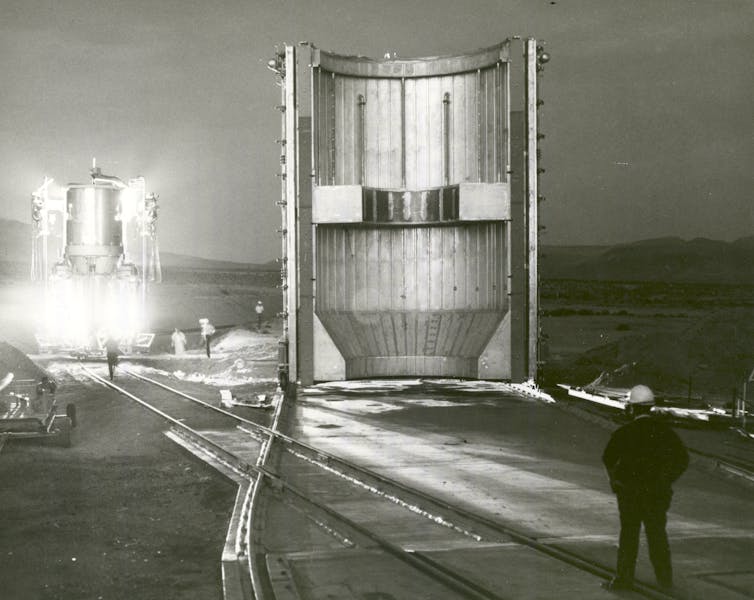
Two options for nuclear
Engineers have designed two main types of nuclear systems for space travel.
The first is called nuclear thermal propulsion . These systems are very powerful and moderately efficient. They use a small nuclear fission reactor – similar to those found in nuclear submarines – to heat a gas, such as hydrogen, and that gas is then accelerated through a rocket nozzle to provide thrust. Engineers from NASA estimate that a mission to Mars powered by nuclear thermal propulsion would be 20%-25% shorter than a trip on a chemical-powered rocket .
Nuclear thermal propulsion systems are more than twice as efficient as chemical propulsion systems – meaning they generate twice as much thrust using the same amount of propellant mass – and can deliver 100,000 Newtons of thrust . That’s enough force to get a car from 0-60 mph in about a quarter of a second.
The second nuclear-based rocket system is called nuclear electric propulsion. No nuclear electric systems have been built yet , but the idea is to use a high-power fission reactor to generate electricity that would then power an electrical propulsion system like a Hall thruster. This would be very efficient, about three times better than a nuclear thermal propulsion system . Since the nuclear reactor could create a lot of power, many individual electric thrusters could be operated simultaneously to generate a good amount of thrust.
Nuclear electric systems would be the best choice for extremely long-range missions because they don’t require solar energy, have very high efficiency and can give relatively high thrust. But while nuclear electric rockets are extremely promising, there are still a lot of technical problems to solve before they are put into use.

Why aren’t there nuclear powered rockets yet?
Nuclear thermal propulsion systems have been studied since the 1960s but have not yet flown in space.
Regulations first imposed in the U.S. in the 1970s essentially required case-by-case examination and approval of any nuclear space project from multiple government agencies and explicit approval from the president. Along with a lack of funding for nuclear rocket system research , this environment prevented further improvement of nuclear reactors for use in space.
That all changed when the Trump administration issued a presidential memorandum in August 2019. While upholding the need to keep nuclear launches as safe as possible, the new directive allows for nuclear missions with lower amounts of nuclear material to skip the multi-agency approval process . Only the sponsoring agency, like NASA, for example, needs to certify that the mission meets safety recommendations. Larger nuclear missions would go through the same process as before.
Along with this revision of regulations, NASA received US$100 million in the 2019 budget to develop nuclear thermal propulsion. DARPA is also developing a space nuclear thermal propulsion system to enable national security operations beyond Earth orbit.
After 60 years of stagnation, it’s possible a nuclear-powered rocket will be heading to space within a decade. This exciting achievement will usher in a new era of space exploration. People will go to Mars and science experiments will make new discoveries all across our solar system and beyond.
[ You’re too busy to read everything. We get it. That’s why we’ve got a weekly newsletter. Sign up for good Sunday reading. ]
- Space Shuttle
- Space exploration
- Donald Trump
- Nuclear fission
- Nuclear fuel
- Rocket Engine

Head of School, School of Arts & Social Sciences, Monash University Malaysia

Chief Operating Officer (COO)

Clinical Teaching Fellow

Data Manager

Director, Social Policy
Nuclear Energy Preferred in Space Travel
Diego valiente february 19, 2015, submitted as coursework for ph241 , stanford university, winter 2015, introduction.
The human race has been enthralled by the exploration of space, but performing major long distance flights proved to be a major challenge since technology in the early stages of space exploration was limited. This frontier of space exploration was finally broken with the use and advancement of nuclear energy. [1] There are several means of creating enough energy to power a spacecraft; however, none are as reliable and as favored as nuclear power when it comes to exploring the solar system past the moon. Innately, space provides for extreme temperatures, dark environments, exposure to radiation, etc. These punishing conditions are not conducive to conventional energy sources. While regular means of power prove to be unsustainable in deep space, nuclear energy provides spacecraft with sufficient power to complete deep space flights.
This report will explore the various power sources that could be used in space travel and explain why nuclear systems are the most practical when performing space missions far from Earth.

Nuclear Energy Superiority Over Other Resources Used In Space Travel
Many are aware of the significant amount of power needed to launch spacecraft into space, but several people overlook the additional electrical power needed by the spacecraft to execute certain tasks, such as communicating back to the home base, managing technical apparatuses, and a variety of other functions. Spacecraft can be powered through a variety of different methods, each with its pros and cons; however, the preferred approach for longer space missions is nuclear energy. The following investigates the primary energy sources used for space travel and will highlight the superiority that nuclear power has in supporting spacecraft.
Batteries - This was the first method used to power spacecraft into space. Batteries soon proved to have some major flaws. [2] Even though batteries gave sufficient power to launch for a short distance, they often lacked the overall power and wattage to support longer missions. Additionally, using batteries for long distance would be futile as those batteries would die well before the mission were to be accomplished.
Fuel Cells - Fuel cells were developed in order to rectify some of the imperfections from batteries. [3] The fuel cell technology increased the wattage and therefore overall energy to power spacecraft. It also enhanced the overall longevity, but despite this improvement in technology fuel cells lacked the sufficient amount of lifetime to support long distance travel.
Photovoltaic - Photovoltaic systems are more commonly used as they last much longer than batteries and fuel cells. [1] They rely heavily on the Sun's light to produce electricity to power spacecraft, which proves to be advantageous when making short missions. Once the missions extend past Mars, the Sun's rays are not as strong, and the solar cells are rendered inadequate.
Nuclear - Nuclear energy proves to be the most effective when attempting to make long distance missions in space. [2] Nuclear energy not only provides way more power than batteries, fuel cells, and photovoltaic, but it also is an enduring source of energy as it has a much longer lifespan. Unlike solar energy, nuclear power is not dependent on the intensity of the Sun's rays, which makes it the optimal choice for traveling into deep space.
Nuclear Energy Efficiency and Sustainability Further Explained
The independence and longevity of nuclear energy makes it far more superior than any other power source currently used in space travel. Nuclear energy could be provided through several different methods such as through reactors, nuclear heaters, and generators. It is important to distinguish the two main types of nuclear energy methods that are utilized in space travel.
RTGS - Radioisotope thermoelectric generators (RTGs) generate power to fuel spacecraft through the heat from the decay of Plutonium-238. [1] This method is essentially the most durable since Plutonium-238's half-life is multiple years, which proves to be an asset when exploring outer space. Despite its long lasting energy source, RTGs are not as efficient at converting this heat into electrical power. Nonetheless, RTGs have been proven to be well equipped to withstand the harsh conditions of deep space.
Fission Reactors - These reactors release heat from nuclear fission and thereby create energy to power spacecraft. [3] Fission reactors are able to create much larger amounts of energy than RTGs, but require more maintenance with its control when launched into deep space.
After discussing the various different methods of supplying power to support spacecraft, and analyzing each method's strength and weaknesses, it should be evident that nuclear energy is the most practical and effective method. Nuclear energy not only has the durability to endure the extreme conditions of outer space, but it also provides spacecraft with long lasting power to make the lengthy trip within our solar system.
© Diego Valiente. The author grants permission to copy, distribute and display this work in unaltered form, with attribution to the author, for noncommercial purposes only. All other rights, including commercial rights, are reserved to the author.
[1] G. L. Bennett, "Space Nuclear Power: Opening the Final Frontier", AIAA 2006-4191 , 4th International Energy Conversion Engineering Conference and Exhibit, San Diego, CA, June 2006.
[2] R. D. Launius, "Powering Space Exploration: U.S. Space Nuclear Power, Public Perceptions, and Outer Planetary Probes," AIAA 2006-4191 , 6th International Energy Conversion Engineering Conference, Cleveland, OH, July 2008.
[3] S. Copeland , " The Role of Nuclear Energy in the Future of Human Spaceflight ," PH241, Stanford University, Winter 2012.
A Plasma Rocket From Nasa Could Send Humans to Mars in Just 2 Months

- Right now it takes roughly eight months for astronauts to travel from Earth to Mars, but if NASA or any other space agencies have hopes of establishing a base on the Red Planet, they’ll need to cut that travel time down significantly.
- Earlier this month, NASA proved that it’s getting serious about its investment into nuclear-powered rockets by moving a fission-based plasma rocket known as the pulse plasma rocket into Phase II funding under the NIAC program.
- This rocket could cut astronaut travel times to Mars down to just two months, or significantly increase payloads for resupply missions—both of which will be crucial for NASA’s future Martian plans.
The logistics of putting living, breathing humans on Mars (and keeping them both living and breathing) is one of the greatest technological challenges in human history. And while heavy lift rockets, nuclear power stations, and even far-fetched ideas like planet-wide terraforming get lots of attention, NASA and other space agencies need to figure out how to overcome one very big obstacle—getting there in the first place.
Of course, NASA has sent plenty of satellites, probes, and rovers to the Red Planet, and the stunning arrival of Perseverance in 2021 put that technological prowess on full display. However, Perseverance’s journey to Mars took more than 7 months, and that’s thanks to Mars’ closest approach to Earth. For a fully fledged outpost on the planet to succeed, NASA will need to cut travel time between planets down as much as possible while increasing payloads. But chemical rockets can only achieve so much.
Luckily, there’s a new kind of rocket that can make these fast travel dreams possible. It’s time to send nuclear rockets to space.
“The NIAC Phase I study focused on a large, heavily shielded ship to transport humans and cargo to Mars for the development of a Martian base,” NASA wrote in a press statement . “Phase II will build upon these assessments and further the PPR concept.”
While chemical rockets, such as NASA’s Space Launch System or SpaceX’s Starship, will likely be the first metal-clad chariots on the Red Planet, the future of spaceflight is undeniably a nuclear one. That’s because concepts like Nuclear Thermal Propulsion (NTP) and Nuclear Electric Propulsion (NEP) have shown that they’re capable of traveling farther and faster while also carrying more cargo than their chemical predecessors.
While this is absolutely game-changing for opening up new possibilities for space missions to the outer Solar System, it’s also important for space travel near Earth, as future travelers to Mars will be subjected to galactic cosmic rays . So, reducing travel times to the Red Planet—while also putting more shielding on the spacecraft itself, which nuclear engines can do thanks to their higher payloads)—is just as much a health benefit as it is an economic one.
“Due to the extremely large distances that are involved in space travel, the spacecraft must reach high velocities for reasonable mission transit times. Thus, a propulsion system that produces a high thrust with a high specific impulse is essential,” NASA wrote. “The exceptional performance of the PPR, combining high Isp and high thrust, holds the potential to revolutionize space exploration. The system’s high efficiency allows for manned missions to Mars to be completed within a mere two months.”
Of course, PPR is only in its early stages, but NASA has other plans for nuclear-powered travel already in the works. In partnership with Lockheed Martin, the space agency is planning to launch the Demonstration Rocket for Agile Cislunar Operations (DRACO)—an NTR concept— sometime in 2027 . While nuclear power has always been a facet of human spaceflight, it’s role as humanity’s primary means of space-based conveyance is quickly becoming a reality.
Darren lives in Portland, has a cat, and writes/edits about sci-fi and how our world works. You can find his previous stuff at Gizmodo and Paste if you look hard enough.

.css-cuqpxl:before{padding-right:0.3125rem;content:'//';display:inline;} Moon and Mars .css-xtujxj:before{padding-left:0.3125rem;content:'//';display:inline;}
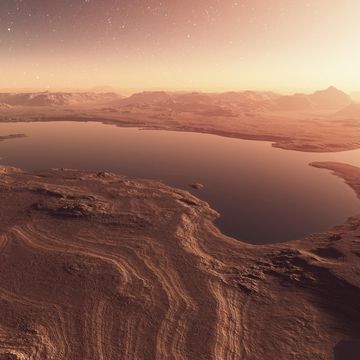
An Unsettling New Image Shows ‘Spiders’ on Mars
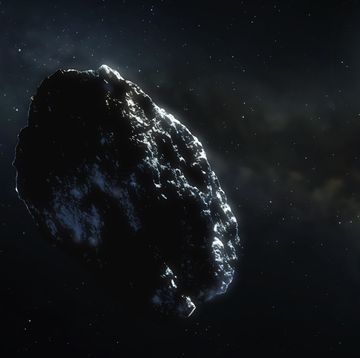
Human-Made Space Debris Could Crash on Mars

How to View the Solar Eclipse

How a Lunar Supercollider Could Upend Physics

The Moon Is Going Nuclear

Private Company to Mine Helium-3 from the Moon

3 Moons Emerged From Around Neptune and Uranus

4 People Are Spending a Year In a Martian World.

America Has Planted Its Feet on the Moon Once More

The Strange Origin of the Hollow Moon Conspiracy

The Moon Is Shrinking Where We're Trying to Land
Space Exploration
Explore space exploration, human spaceflight, launches & spacecraft, private spaceflight, search for life, latest about space exploration.
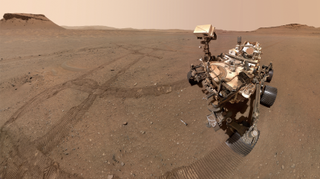
NASA's wants new ideas for its troubled Mars Sample Return mission
By Brett Tingley published 7 June 24
NASA's Mars Sample Return mission has faced quite a few hurdles, and the agency has selected ten studies to try and find more affordable and quicker means of going about the project.

Virgin Galactic eyes June 8 for final commercial spaceflight on VSS Unity spaceplane
By Meredith Garofalo published 7 June 24
Virgin Galactic aims to launch its seventh commercial spaceflight mission on June 8 during the final flight of its VSS Unity suborbital spaceplane.
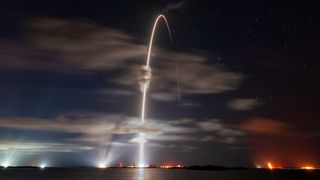
SpaceX launching 22 Starlink satellites from Florida tonight
By Mike Wall published 7 June 24
SpaceX plans to launch yet another batch of its Starlink internet satellites from Florida's Space Coast tonight (June 7).
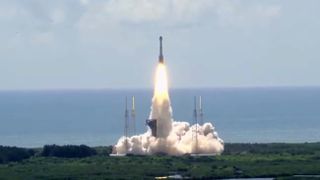
Boeing Starliner 1st astronaut flight: Live updates
By Elizabeth Howell, Tariq Malik last updated 7 June 24
Boeing moving toward a June 1 launch of its first-ever Starliner astronaut mission for NASA.
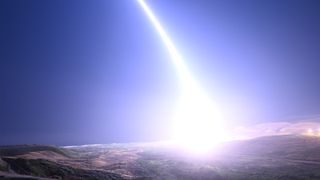
US military test launches 2 unarmed intercontinental ballistic missiles in 2 days
The United States Air Force and U.S. Space Force conducted two routine test launches of unarmed intercontinental ballistic missiles this week from Vandenberg Space Force Base.

On this day in space! June 7, 1965: NASA's Gemini 4 mission returns to Earth
By Hanneke Weitering last updated 7 June 24
On June 7, 1965, after a four-day mission and 62 orbits, NASA's Gemini 4 mission returned to Earth with an Atlantic Ocean splashdown.

South Korea creates new KASA space agency, sets sights on the moon and Mars
By Andrew Jones published 7 June 24
South Korea has announced the creation of a new space agency and is aiming to land its own spacecraft on the moon and Mars in the coming decades.

'Sudden, brief, and unexpected:' dearMoon crew laments cancellation of private SpaceX Starship moon mission
By Samantha Mathewson published 7 June 24
Crew members selected for a planned flight around the moon funded by Japanese billionaire Yusaku Maezawa shared public feelings of disappointment after the mission's cancellation.

A billionaire wanted to save the Hubble Telescope — here's why NASA politely declined
By Monisha Ravisetti published 7 June 24
Billionaire Jared Isaacman wanted to conduct a private Hubble Telescope reboost mission. NASA says 'not yet.'
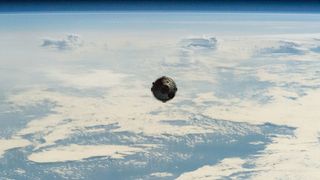
Thruster glitches and helium leaks can't stop Boeing's Starliner astronaut test flight — but why are they happening?
By Tariq Malik published 7 June 24
Boeing's Starliner Crew Flight Test faced down thruster glitches and helium leaks to reach the International Space Station on June 6. Why all the glitches and is NASA worried?
Get the Space.com Newsletter
Breaking space news, the latest updates on rocket launches, skywatching events and more!
- 2 Virgin Galactic eyes June 8 for final commercial spaceflight on VSS Unity spaceplane
- 3 SpaceX launching 22 Starlink satellites from Florida tonight
- 4 Jupiter's raging gas cyclones may actually mirror Earth's oceans. Here's how
- 5 Why is Neptune's magnetic field so weird? An exotic molecule may be the answer
Ukraine-Russia war latest: Vladimir Putin repeats warning he could send weapons to adversaries of the West
Speaking at the St Petersburg International Economic Forum, Vladimir Putin also says he does not see the conditions for the use of nuclear weapons as set out in Russia's nuclear doctrine - but adds he could not rule out a change to it.
Friday 7 June 2024 17:15, UK
Please use Chrome browser for a more accessible video player
- Russia economically strong despite 'illegitimate sanctions'
- Ukraine has right to strike targets in Russia - NATO chief
- Russian vessels to make port in Cuba in 'hopes of invoking memory of missile crisis'
- Biden to discuss $225m package with Zelenskyy in France
- Ivor Bennett: Why is Lavrov in Africa?
- Big picture: Everything you need to know about the war right now
- Your questions answered: Are there any signs of an underground resistance in Russia?
Thank you for reading.
We will be back soon with more updates from the war in Ukraine.
Vladimir Putin has said he does not see the conditions for the use of nuclear weapons as set out in Russia's nuclear doctrine - but added he could not rule out a change to the doctrine.
"We have a nuclear doctrine which states that the use of nuclear arms is possible in an exceptional case, when the sovereignty and territorial integrity of our country is threatened," he told the St Petersburg International Economic Forum.
"But the doctrine can be changed.
"The same applies to nuclear tests. We will carry out tests if needed, but so far there is no such need."
Russia could send weapons to adversaries of the West, Vladimir Putin has warned for a second time.
The Russian president repeated the warning from earlier this week during the St Petersburg Economic Forum.
He did not say what countries or entities he was referring to, and he stressed that Moscow is not doing it currently.
"If they supply (weapons) to the combat zone and call for using these weapons against our territory, why don't we have the right to do the same?" he told the crowds.
"But I'm not ready to say that we will be doing it tomorrow, either."
On Wednesday, Putin told international journalists that Russia could provide long-range weapons to others to strike Western targets in response to NATO allies allowing Ukraine to use their arms to attack Russian territory.
He also reaffirmed Moscow's readiness to use nuclear weapons if it sees a threat to its sovereignty.
Joe Biden has apologised to Volodymyr Zelenskyy for the recent delay in approving new US aid for Ukraine.
Last month, following months of political disagreements, the Senate passed $95bn (£76.2bn) in war aid to Ukraine, Israel and Taiwan .
"I apologise for those weeks of not knowing," the US president said.
"Some of our very conservative members [of Congress] were holding it up.
"But we got it done, finally. We're still in - completely, totally."
The Ukrainian president thanked his counterpart for American assistance.
"It's very important that you stay with us," he said.
"It's very important that in this unity, the United States of America, all American people stay with Ukraine, like it was during World War Two - how the United States helped to save human lives, to save Europe."
The two men were speaking in Paris, the day after D-Day commemorations in Normandy.
Russia needs to boost its use of non-Western currencies, Vladimir Putin said as he addressed the St Petersburg International Economic Forum.
He also said his country needs to reduce imports while calling for a major expansion of its domestic financial markets.
Trade with Asia is soaring, he told delegates, adding that almost two fifths of Russian external trade is now in roubles.
The share conducted in US dollars, euros and other Western currencies has declined.
Russia will try to boost the share of settlements conducted in the currencies of BRICS countries - which include Brazil, Russia, India, China and South Africa, Mr Putin said.
"Last year, the share of payments for Russian exports in the so–called 'toxic' currencies of unfriendly states halved, while the share of the rouble in export and import transactions is growing - it is approaching 40% today," the president said.
Russia has referred to nations that imposed sanctions on it as "unfriendly".
The session begins with an address by the Russian president.
Vladimir Putin says there is a race among world powers to establish sovereignty.
He speaks of the need for countries to both establish partnerships and also to look internally to tackle challenges presented by the current global economic landscape.
Despite all the "obstacles and illegitimate sanctions", Russia remains one of the world's economic leaders, he says.
He adds that "friendly countries" - those that have not joined sanctions against Moscow - account for three quarters of Russia's mutual trade turnover, and praises them for that.
Countries including India and China have strengthened economic ties since Mr Putin launched his war in Ukraine.
Vladimir Putin has taken to the stage in St Petersburg to address the International Economic Forum there.
He's joined by Zimbabwean President Emmerson Mnangagwais and Bolivian President Luis Alberto Arce Catacora.
Chairing the session is Sergey Karaganov - a Russian political scientist.
We'll bring you any key lines here in this live blog.
A T-shirt is on sale at the St Petersburg International Economic Forum printed with a phrase attributed to Vladimir Putin, Sky News has discovered.
"If a fight is inevitable, throw the first punch," it says.
The Russian president reportedly said it in 2015.
He apparently explained that it was something he had learned while growing up on the streets of Leningrad - a former name of St Petersburg.
The Russian defence ministry has accused Ukraine of injuring 20 people, including children, in a missile attack on the Russian-controlled eastern Ukrainian city of Luhansk, using US-supplied ATACMS missiles.
Four of five missiles were shot down by air defence systems, the ministry said in a statement.
However, one of the missiles damaged two residential apartment blocks, it added, claiming it was deliberate.
Sky News is unable to verify the allegations.
There has been no immediate comment from Ukraine.
The European Commission supports starting EU accession talks with Ukraine, the country's prime minister has said.
Denys Shmyhal said the commission had confirmed in a report that Kyiv had fulfilled the remaining steps required to start negotiations.
"Now we expect our European partners to take the next step - to start negotiations on European Union membership this month," Mr Shmyhal said on Telegram.
Earlier (7.43am post) we reported that the commission was reportedly ready to recommend that accession talks get underway.
It is part of an attempt to signal support for Kyiv before Hungary takes over the rotating presidency of the EU next month, the Financial Times reported.
The EU announced earlier this year that it was sending an additional £42bn in aid to Ukraine - but only after weeks of resistance from Hungary , which reportedly has concerns about minority rights in Ukraine.
Be the first to get Breaking News
Install the Sky News app for free


Suggested Searches
- Climate Change
- Expedition 64
- Mars perseverance
- SpaceX Crew-2
- International Space Station
- View All Topics A-Z
Humans in Space
Earth & climate, the solar system, the universe, aeronautics, learning resources, news & events.

NASA, Global Astronomers Await Rare Nova Explosion

NASA Scientists Take to the Seas to Study Air Quality

NASA to Change How It Points Hubble Space Telescope
- Search All NASA Missions
- A to Z List of Missions
- Upcoming Launches and Landings
- Spaceships and Rockets
- Communicating with Missions
- James Webb Space Telescope
- Hubble Space Telescope
- Why Go to Space
- Commercial Space
- Destinations
- Living in Space
- Explore Earth Science
- Earth, Our Planet
- Earth Science in Action
- Earth Multimedia
- Earth Science Researchers
- Pluto & Dwarf Planets
- Asteroids, Comets & Meteors
- The Kuiper Belt
- The Oort Cloud
- Skywatching
- The Search for Life in the Universe
- Black Holes
- The Big Bang
- Dark Energy & Dark Matter
- Earth Science
- Planetary Science
- Astrophysics & Space Science
- The Sun & Heliophysics
- Biological & Physical Sciences
- Lunar Science
- Citizen Science
- Astromaterials
- Aeronautics Research
- Human Space Travel Research
- Science in the Air
- NASA Aircraft
- Flight Innovation
- Supersonic Flight
- Air Traffic Solutions
- Green Aviation Tech
- Drones & You
- Technology Transfer & Spinoffs
- Space Travel Technology
- Technology Living in Space
- Manufacturing and Materials
- Science Instruments
- For Kids and Students
- For Educators
- For Colleges and Universities
- For Professionals
- Science for Everyone
- Requests for Exhibits, Artifacts, or Speakers
- STEM Engagement at NASA
- NASA's Impacts
- Centers and Facilities
- Directorates
- Organizations
- People of NASA
- Internships
- Our History
- Doing Business with NASA
- Get Involved
- Aeronáutica
- Ciencias Terrestres
- Sistema Solar
- All NASA News
- Video Series on NASA+
- Newsletters
- Social Media
- Media Resources
- Upcoming Launches & Landings
- Virtual Events
- Sounds and Ringtones
- Interactives
- STEM Multimedia

Amendment 19: D.18 Euclid General Investigator Program: Names must be omitted from References.

PACE Celebrates National Ocean Month With Colorful Views of the Planet
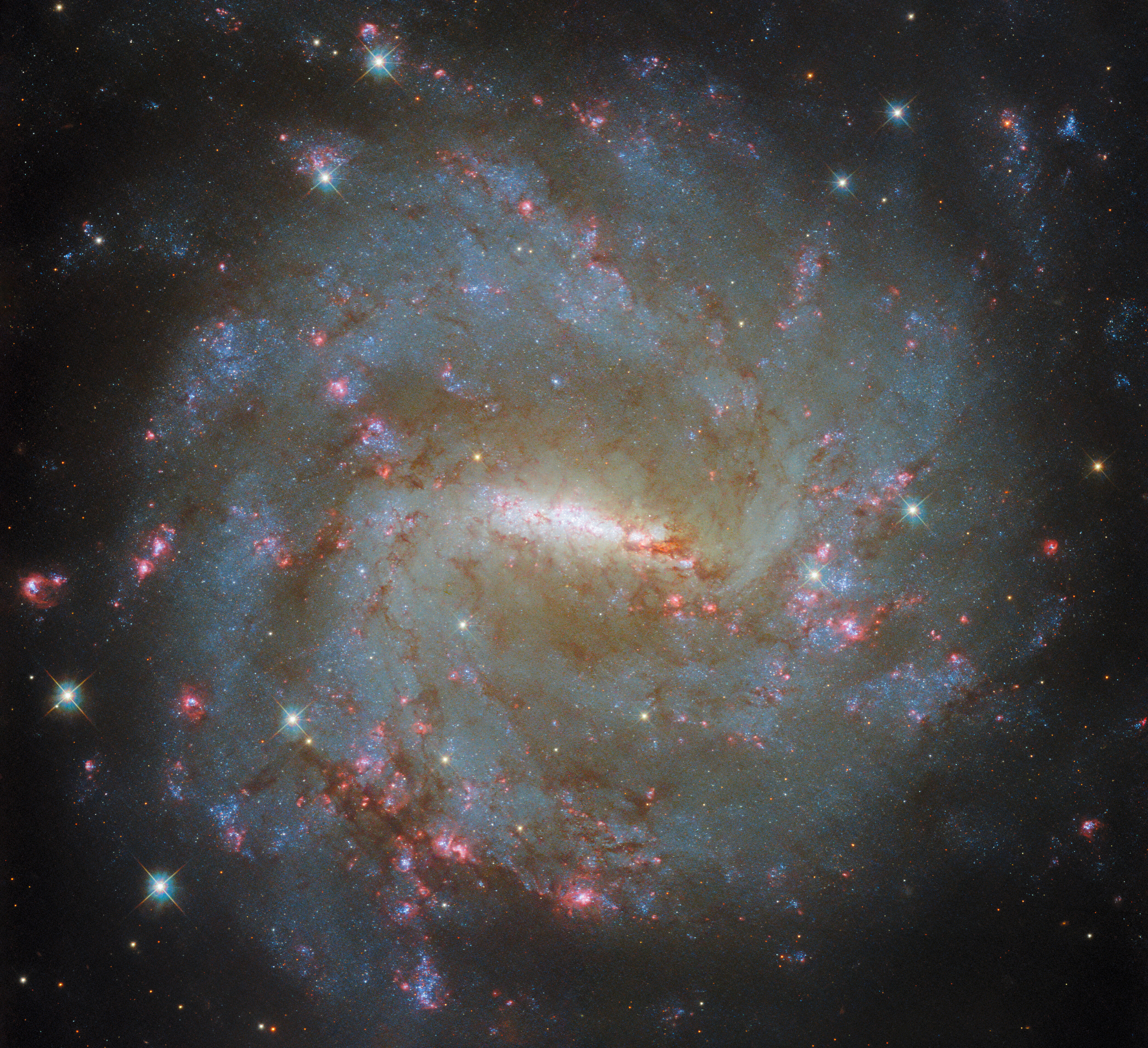
Hubble Examines a Barred Spiral’s Light

NASA Astronauts Practice Next Giant Leap for Artemis

Former Astronaut David R. Scott

Space Station Research Advances NASA’s Plans to Explore the Moon, Mars

NASA Mission Flies Over Arctic to Study Sea Ice Melt Causes

Webb Finds Plethora of Carbon Molecules Around Young Star

Solid State Quantum Magnetometers—Seeking out water worlds from the quantum world

C.12 Planetary Instrument Concepts for the Advancement of Solar System Observations POC Change

The Big Event, 2025

Black Hole Week

Amendment 20: F.20 MOSAICS Seed Funding formerly SMD Bridge Program Seed Funding Final Text.

ARMD Solicitations

Winners Announced in Gateways to Blue Skies Aeronautics Competition

NASA, Industry to Start Designing More Sustainable Jet Engine Core

B.10 Heliophysics Flight Opportunities Studies Correction

Tech Today: Measuring the Buzz, Hum, and Rattle

Artemis Generation Shines During NASA’s 2024 Lunabotics Challenge

NASA Marshall Engineer Receives AIAA Honors Award

Meet the Simunauts: Ohio State Students to Test Space Food Solutions for NASA

Diez maneras en que los estudiantes pueden prepararse para ser astronautas

Astronauta de la NASA Marcos Berríos

Resultados científicos revolucionarios en la estación espacial de 2023
The physics remain the same, but the rockets, spacecraft, landers, and spacesuits are new as NASA and its industry partners prepare for Artemis astronauts to walk on the Moon for the first time since 1972.
NASA astronaut Doug “Wheels” Wheelock and Axiom Space astronaut Peggy Whitson put on spacesuits, developed by Axiom Space , to interact with and evaluate full-scale developmental hardware of SpaceX’s Starship HLS (Human Landing System) that will be used for landing humans on the Moon under Artemis. The test, conducted April 30, marked the first time astronauts in pressurized spacesuits interacted with a test version of Starship HLS hardware.
“With Artemis, NASA is going to the Moon in a whole new way, with international partners and industry partners like Axiom Space and SpaceX. These partners are contributing their expertise and providing integral parts of the deep space architecture that they develop with NASA’s insight and oversight,” said Amit Kshatriya, NASA’s Moon to Mars program manager. “Integrated tests like this one, with key programs and partners working together, are crucial to ensure systems operate smoothly and are safe and effective for astronauts before they take the next steps on the Moon.”
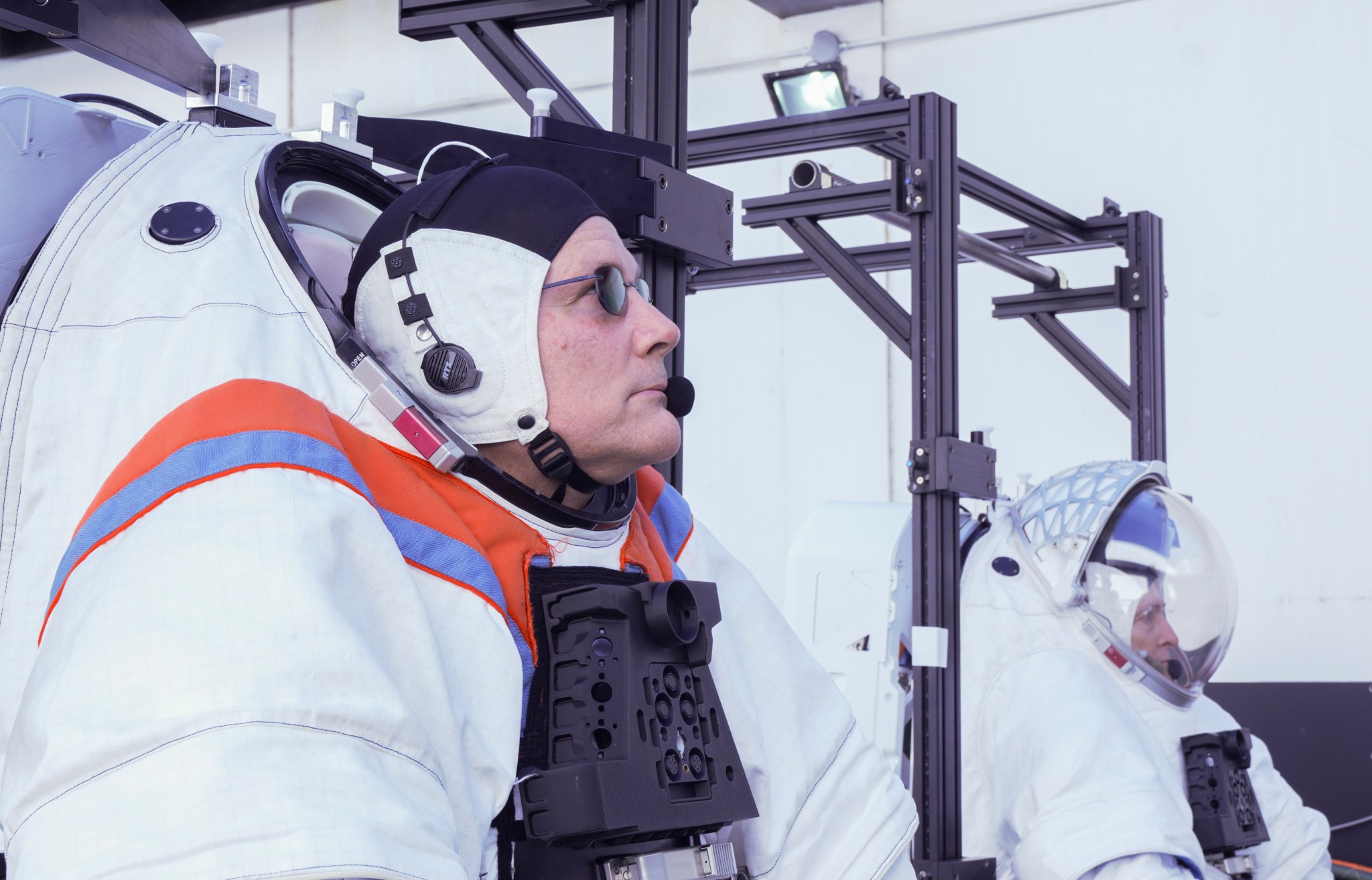
The day-long test, conducted at SpaceX headquarters in Hawthorne, California, provided NASA and its partners with valuable feedback on the layout, physical design, mechanical assemblies, and clearances inside the Starship HLS, as well as the flexibility and agility of the suits, known as the AxEMU (Axiom Extravehicular Mobility Unit).
To begin the test, Wheelock and Whitson put on the spacesuits in the full-scale airlock that sits on Starship’s airlock deck. Suits were then pressurized using a system immediately outside the HLS airlock that provided air, electrical power, cooling, and communications to the astronauts. Each AxEMU also included a full-scale model of the Portable Life Support System, or “backpack,” on the back of the suits. For Artemis moonwalks, each crew member will put on a spacesuit with minimal assistance, so the team was eager to evaluate how easily the suits can be put on, taken off, and stowed in the airlock.
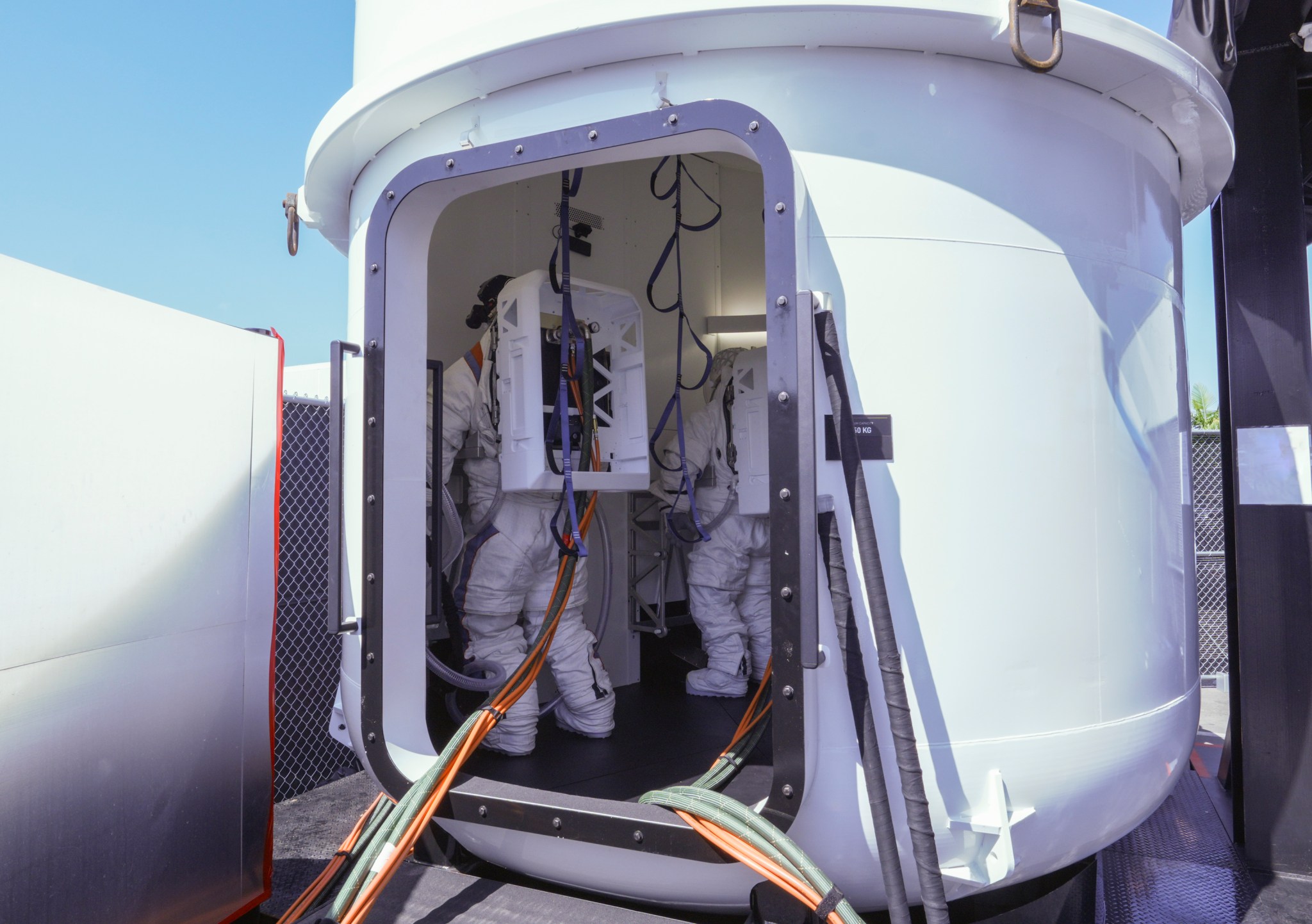
During the test, NASA and SpaceX engineers were also able to evaluate placement of mobility aids, such as handrails, for traversing the hatch. Another set of mobility aids, straps hanging from the ceiling in the airlock, assisted the astronauts when entering and removing the AxEMU suits. The astronauts also practiced interacting with a control panel in the airlock, ensuring controls could be reached and activated while the astronauts were wearing gloves.
“Overall, I was pleased with the astronauts’ operation of the control panel and with their ability to perform the difficult tasks they will have to do before stepping onto the Moon,” said Logan Kennedy, lead for surface activities in NASA’s HLS Program. “The test also confirmed that the amount of space available in the airlock, on the deck, and in the elevator, are sufficient for the work our astronauts plan to do.”
The suited astronauts also walked the from Starship’s airlock deck to the elevator built for testing. During Artemis missions, the elevator will take NASA astronauts and their equipment from the deck to the lunar surface for a moonwalk and then back again. Whitson and Wheelock practiced opening a gate to enter the elevator while evaluating the dexterity of the AxEMU suit gloves, and practiced lowering the ramp that astronauts will use to take the next steps on the Moon.
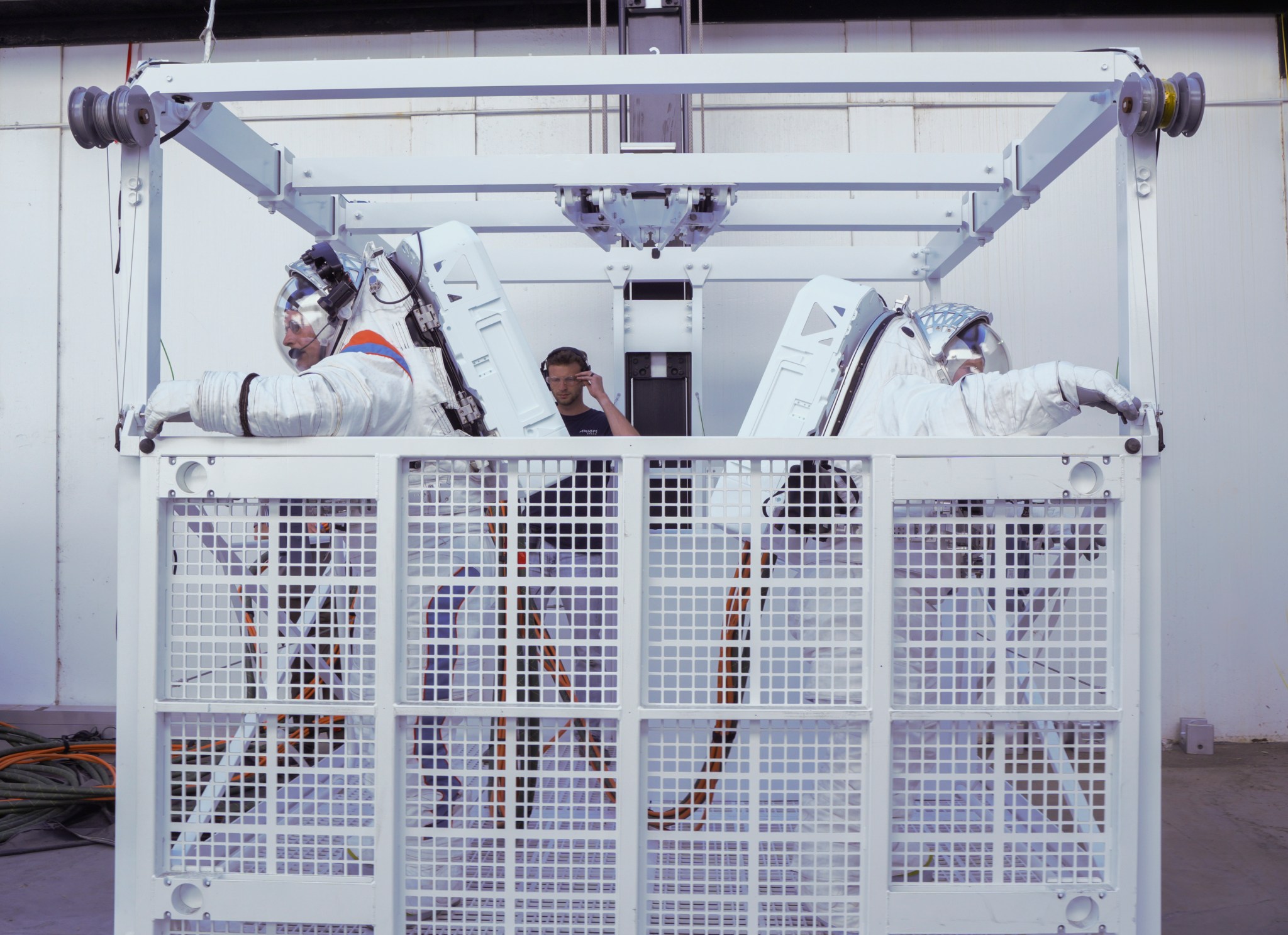
The steps the astronauts took in the spacesuits through full-scale builds of the Starship hatch, airlock, airlock deck, and elevator may have been small, but they marked an important step toward preparing for a new generation of moonwalks as part of Artemis.
For the Artemis III mission, SpaceX will provide the Starship HLS that will dock with Orion in lunar orbit and take two astronauts to and from the surface of the Moon. Axiom Space is providing a new generation of spacesuits for moonwalks that are designed to fit a wider range of astronauts.
With Artemis, NASA will explore more of the Moon than ever before, learn how to live and work away from home, and prepare for future human exploration of the Red Planet. NASA’s SLS (Space Launch System) rocket, exploration ground systems, and Orion spacecraft, along with the human landing system, next-generation spacesuits, Gateway lunar space station, and future rovers are NASA’s foundation for deep space exploration.
For more information about Artemis, visit:
https://www.nasa.gov/artemis

IMAGES
VIDEO
COMMENTS
The KIWI A prime nuclear thermal rocket engine Mars Curiosity rover powered by a RTG on Mars. White RTG with fins is visible at far side of rover. Nuclear power in space is the use of nuclear power in outer space, typically either small fission systems or radioactive decay for electricity or heat. Another use is for scientific observation, as in a Mössbauer spectrometer.
Space Nuclear Propulsion. Space nuclear propulsion is a technology that draws energy from fission instead of traditional chemical reactions, thus providing virtually unlimited energy density and opening the door for crewed missions to Mars and deep space science. NASA is looking at two types of nuclear propulsion systems - thermal and electric.
The nuclear fusion feat has broad implications, fueling hopes of clean, limitless energy. As for space exploration, one upshot from the landmark research is attaining the long-held dream of future ...
Humanity is poised to embark on a new age of space travel to Mars, our solar system and beyond as nuclear power and related technologies promise to make interplanetary missions faster, more efficient and economical. These were the conclusions of a panel of international experts from the public and private sectors at this week's IAEA webinar, "Atoms for Space: Nuclear Systems
Gina Anderson. Headquarters, Washington. 202-358-1160. [email protected]. Jan Wittry. Glenn Research Center, Cleveland. 216-433-5466. [email protected]. NASA and the Department of Energy's National Nuclear Security Administration (NNSA) have successfully demonstrated a new nuclear reactor power system.
Nuclear energy has safely and successfully powered U.S. space travel for over half a century. Now, recent investments in new nuclear technologies have the potential to revolutionize space travel. Think Star Trek's famous quote: "to boldly go where no man has gone before." These new technologies could help us get to Mars faster, create ...
The future of manned space exploration and development of space depends critically on the creation of a dramatically more proficient propulsion architecture for in-space transportation. A very persuasive reason for investigating the applicability of nuclear power in rockets is the vast energy density gain of nuclear fuel when compared to ...
In less than four years, NASA could be testing a nuclear rocket in space. The space agency and the Defense Advanced Research Projects Agency, or DARPA, announced on Wednesday that Lockheed Martin ...
NTP will enable faster space travel than ever before. Increased speed from NTP means benefits like longer launch windows, less crew exposure to cosmic radiation in space and satellites and robotic spacecraft getting to their destinations quicker or with much higher mass. The speed of NTP comes from its high-efficiency thrust—upwards of two ...
Credit: NASA. WASHINGTON — Space vehicles powered by small nuclear reactors — a technology that NASA believes could help get humans to Mars faster — also could be used for military missions ...
DARPA. NASA has hired Lockheed Martin to design, build, and test a nuclear-powered rocket for space travel. The technology could speed up a manned trip to Mars from the current seven-month minimum ...
NASA and the U.S. Department of Energy (DOE) have teamed up to fund three design concepts for reactors that could become part of a nuclear thermal propulsion system, a next-generation technology ...
EARLY NUCLEAR SPACE POWER SYSTEMS. In 1961, the U.S. Navy's Transit 4A navigation satellite became the first U.S. spacecraft to be powered by nuclear energy. Transit 4A was powered by a radioisotope thermoelectric generator, or RTG, developed by the Atomic Energy Commission, the predecessor to the Energy Department.
Atoms for Propulsion: Rockets powered by nuclear fission or fusion are now vying to become the preferred (and faster) means of traveling the solar system. For all the controversy they stir up on ...
In theory, nuclear propulsion for space travel will offer two significant advantages over chemical propulsion. First, since nuclear systems are much more efficient, the amount of fuel required for the journey to Mars is practical. Second, without a need to traverse the shortest path, the flight could take off from Earth and Mars anytime ...
NASA has revealed plans to create a nuclear-powered rocket that could send astronauts to Mars in just 45 days. The agency, which has partnered with the Pentagon's Defense Advanced Research ...
The work on Nuclear Thermal Propulsion (NTP) is under the auspices of the Space Technology Mission Directorate's Game Changing Development Program. Today's advances in materials, testing capabilities, and reactor development are providing impetus for NASA to appraise Nuclear Thermal Propulsion (NTP) as an.
Nuclear Rockets and Travel to Mars. Determining the fuel for nuclear rockets is only the first step toward nuclear space travel. As Emrich points out, the work done at NTREES is only the beginning in a long process toward viable nuclear-powered rockets. "Once the testing is complete, you have to take the fuel and put it into a nuclear reactor.
There are two reasons faster rockets are better for long-distance space travel: safety and time. ... The uranium fuel used in nuclear reactors has an energy density that is 4 million times higher ...
This has led many to turn to nuclear energy as a potential replacement for chemical fuel in spacecraft. [1] Spacecraft Propulsion. Space travel consists of 2 main energy-expensive procedures: lift-off and acceleration. [2] Lift-off is the ejection of the spacecraft from the Earth's atmosphere. Once out of the Earth's atmosphere, spacecraft ...
Nuclear energy could be provided through several different methods such as through reactors, nuclear heaters, and generators. It is important to distinguish the two main types of nuclear energy methods that are utilized in space travel. RTGS - Radioisotope thermoelectric generators (RTGs) generate power to fuel spacecraft through the heat from ...
NASA is currently working with the Department of Energy (DOE) to advance space nuclear technologies. • NASA's space nuclear technologies program is led and funded by the Space Technology Mission Directorate and is based at NASA's Marshall Space Flight Center in Huntsville, Alabama. • The reactor would utilize high-assay low-enriched ...
NASA's goal is to minimize the time the crew travels between Earth and Mars to as close to two years as is practical. Space nuclear propulsion systems could enable shorter total mission times and provide enhanced flexibility and efficiency for mission designers. To keep the round-trip crewed mission duration to about two years, at a minimum ...
It's time to send nuclear rockets to space. And it appears that NASA agrees. Earlier this month, the space agency's NASA Innovative Advanced Concepts—which is in charge of funding ambitious ...
South Korea has announced the creation of a new space agency and is aiming to land its own spacecraft on the moon and Mars in the coming decades. Human Spaceflight 'Sudden, brief, and unexpected ...
Vladimir Putin has said he does not see the conditions for the use of nuclear weapons as set out in Russia's nuclear doctrine - but added he could not rule out a change to the doctrine.
NASA astronaut Doug "Wheels" Wheelock and Axiom Space astronaut Peggy Whitson put on spacesuits, developed by Axiom Space, to interact with and evaluate full-scale developmental hardware of SpaceX's Starship HLS (Human Landing System) that will be used for landing humans on the Moon under Artemis. The test, conducted April 30, marked the ...